#which is why it's so unique in terms of ancient art because other societies with different governmental structures which didn't focus so
Explore tagged Tumblr posts
Text
anyway more republican art posting but. the characterization of republican art and the notions of personal appearance in that period make it so interesting to me. i think pliny said this when i was reading him talking about the ancestral imagines but he basically characterizes a 'decline' of art from the republican era to his time, essentially with art becoming less about showing the individual characteristics and personality of a person and more iconographic/about projecting things like wealth or power rather than capturing individual features. essentially he says portraits became more of a 'stereotype' which signalled what kind of person you were, rather than a portrait of your particular face. which i think, although i don't really know how right pliny was about his own time obviously, is definitely something which characterizes republican art in the cursory glance at roman art history i've taken; ie the focus on capturing idiosyncratic and individual portraits of people (even to the point of possibly exaggerating them, almost like a caricature) in order to capture almost something about their soul. i think this is why i find that era of portrait busts so alluring, and though there are also definitely imperial era ones which have the same idea of capturing an individual, the republican ones hit different imo
#pliny nat.hist. 34.4- btw#it's really interesting that this style of portraiture seems to have evolved specifically out of the republican political milieu#which is why it's so unique in terms of ancient art because other societies with different governmental structures which didn't focus so#much on individual glory but also specifically building a family legacy out of individual glory (both separate and intertwined - the family#wouldn't get you to the end but it could start you off. you still had to make your own mark to get anywhere - you couldn't always just coas#off family connections)#so it's these aristocratic dynasties but a great amount of focus on the individuals within them and how they shaped up to their ancestors#and i think this general mindset created that art style (verism) and made it very. representative of the repulican zeitgeist#even outside of that political context . it echoes it. idk. the roman urge to say look at me. im an old man. im an important old man.#a particular old man. remember every wrinkle on my old man face. yeah
1 note
·
View note
Text
Alright it's time for a rant! Let's talk about canon vs. fanon. This is gonna be a long one folks, so buckle up!
I see a lot of people complaining about fan interpretations of characters in art or fan works or even headcanons not lining up with the canon depictions of the characters and this always sort of bugs me a bit. I think we need to reframe how we approach the idea of canon vs. fanon.
I want to start off by saying I'm a writer. I have a degree in creative writing and have had at least one publication at the time of posting. I know what it's like to pour your heart and soul into a project and into creating these characters and the world they live in. So I can somewhat see where people are coming from when they talk about the importance of sticking to the author's vision. The author put a lot of love into that character and their interpretation is, of course, paramount. But I don't think that this necessarily means that contrary fanon interpretations can't exist.
I'd like to draw a comparison to mythology, if I may. Ancient mythology is one of my special interests and I took multiple classes on different mythologies during my time in undergrad. The professor for those classes was amazing and one thing that he said that will always stick with me is something he'd teach on the first day of any of his mythology classes: "Myth is multiform".
Ok so what does "myth is multiform" mean? Well in simple terms it means that when it comes to mythology, there is no one "correct" telling of the story. Mythology at its root was an oral tradition. It didn't have an author. These stories were built and shaped by the dozens or hundreds of people who told them. And with each telling, the new storyteller would add a little bit of their own unique flair to the story. They might change a detail they never liked or couldn't remember correctly or they might add in details where there weren't any the first time they heard it. And as this keeps happening, the story changes a lot between people and cities and villages and even time. So if you hear one story where Aphrodite's hair was blonde and another where it was red, which detail is correct? Both. Because myth is multiform. The story is changed and affected by those who interact with it.
This can even be seen in modern interpretations of classic myth. The way we tell the stories now is drastically different from how they were told back then. For example, a lot of people who are really into Greek mythology see Athena as somewhat of a feminist icon. A lot of modern depictions of her show her as a strong and independent woman. But the Athena of ancient Greece, while strong, was a model goddess for upholding the patriarchal system of society at the time. She was known for following laws and customs to the letter, including and sometimes especially misogynistic ones. To put it bluntly, she was not a girl's girl.
But today we emphasize the parts of her that feel strong and empowering. We see the goddess of justice and war who fights for herself and stands up for what she believes is right. So which Athena is real? I mean, one is directly from the time period, so that one must be the true one, right? Wrong. They are both the real Athena. Because myth is multiform.
"Yeah, ok," you say, "but modern media isn't mythology. It's not an oral tradition. It has authors and we can identify exactly what the original story was." And that's true. But once a story exists, once it is shared with others, it becomes more than itself. Even on the most basic level, an author isn't capable of conveying literally every detail and meaning they had in mind while creating it into the actual piece. Some things--many things, really--are left to interpretation. That's why we have high school literature teachers asking why you think the curtains are blue in some random scene of a book.
And every person is going to bring their own prior knowledge and life experiences to that story which will impact how they interpret it. So as soon as one person has heard your story, there are already two versions of the story in existence--the one you wrote and the one they read. The words on the page might be the same but all the little gaps are filled in differently depending on the person. There are things an author can do to steer their audience in the direction they want them to interpret things in, but your reader/listener/viewer is never going to get 100% of the meaning you put into it.
All this to say, when a story reaches fandom, it essentially becomes myth. All the slightly different little versions of these worlds and characters are floating around in people's heads and as they talk to one another about it and share their ideas and interpretations, those versions grow and evolve beyond the original work.
Fanon versions of characters don't come out of nowhere; they're slowly molded and shaped by the community surrounding them using the basis of the source material and then combining collective experiences and attitudes of fans. They grow with the community, just as a myth grows with its culture.
So my point here isn't to say that all interpretations of a character are equally true to source and should be treated as such, but rather to say that characters evolve when touched by the hearts of people who love them and enjoy their stories and while the canon character is valid and beloved in their stagnancy, fanon versions can exist at the same time without threatening the canon character's status.
Just because an interpretation of a character that you see a lot might be wildly different from the character's existence in canon, that doesn't inherently make it bad. It shows the impact of human experience and community on art and the two characters can coexist separately without one needing to wipe the other out.
#I also wanna note that this is not talking about instances of removing representation or anything like that.#there is a difference between blatantly removing character traits that represent real people and slightly shifting their personality#anyway rant over#if anything was unclear im happy to answer questions#all i ask is that you be kind#fandom#canon vs fanon#rant
0 notes
Text
Anonymous asked: I’m a college adjunct professor in the liberal arts and I confess I like plenty of your posts on your blog which give food for thought, the rest of it I violently disagree. Despite your Oxbridge education in the Classics I’m perplexed that a blog dedicated to high culture should spend time glorifying war. I get that you served in Afghanistan with the Royal Army as a combat pilot so that’s your lived experience. My question is why do you post on military history, especially classical civilization, which just glorifies dead white men? Isn’t the study of classics passé today? I don’t see what our progressive society can possibly learn from dead Greeks and Romans.
Thank you for reaching out and I appreciate your comments. Let me get a few things out of the way before I get to the heart of your question. I’ve never understood the term violently disagree, what does that even mean? Does it mean resorting to violence to further or finish an argument? I hope not.
I don’t mean to pick on you but I find it weird that it’s often modern educated liberal leftists (and their far right counterparts I should add) who’ve never seen real violence or been violent themselves - because they’re benignly bourgeois and happy to comment on things that outrage them from the safety of the sidelines - but leave the actual fighting in a real war to others.
In the British case it’s the working class and the upper middle and upper classes (the historic structure of the British army) but in the US the vast majority of those who serve come from blue collar and middle class backgrounds but not the well off college educated elite, so that progressives and everyone else for that matter can enjoy the comfortable bourgeois lives they lead but happily shit on the sacrifices of the very same people who fight for the way of life they take for granted.

Anyway, I’m venting, and for that I apologise. Of course we can disagree but I hope not violently. I prefer civility regardless of how passionate one’s beliefs are. There’s no point winning an argument if you don’t win over the person too. In that spirit let us continue.
I’m not going to defend the study of Classics as a whole here. I’ve addressed that question elsewhere in my blog and perhaps it would make my tutors at Cambridge blush but here’s my piss poor attempt nonetheless (click on this link to the blog post)
Otherwise there are plenty of excellent Ancient Greek and ancient world related blogs well worth your time to browse through and even learn from about the importance of the ancient world. Here are just a few:
I would recommend the following:
https://gemsofgreece.tumblr.com/
https://www.tumblr.com/alatismeni-theitsa
https://wordsmithic.tumblr.com/
https://thoodleoo.tumblr.com/
Just another house keeping point. It may sound trivial but it’s important. It’s just the British Army not the Royal British army. I’m assuming you’re American and so it’s understandable that you’re more likely to make that error because you’re not British. We have a Royal Navy and even a Royal Air Force but curiously not a Royal Army. Why that is so is rooted in our peculiar British history going back to Charles I and II. The Royal Navy was always loyal to the monarchy during the war with Parliament and so it kept the Royal bit. The army not so much. Indeed the origin of the British army was Cromwell and his famed New Model Army, in other words, it was an instrument of Parliament. Since the restoration of the throne all army officers and soldiers swear an oath of loyalty to the reigning monarch.

But it’s also true there is alternative legitimate argument that there never has been a British army per se, just a tribal collection of regiments with their own roots to a community, proud traditions and rituals unique to that regiment, and fiercely guarded independence.
The argument goes that the British Army actually goes further back than the English civil war of Cromwell and Charles I. A monarch would raise a force by calling on his nobleman to call their own men from their lands to arms and fight for him (a regiment). Only a very, very small proportion of an army would be directly paid and commanded by the monarch. By contrast, as far back as the Saxon period, English/British monarchs have maintained a fleet of warships at their own expense.
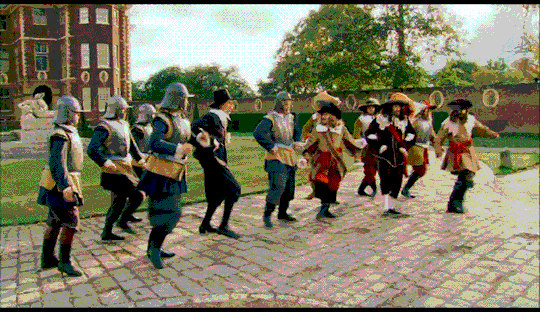
From the Restoration onwards there were still lingering distrust between Parliament and the monarchy, especially over the issue of a standing army, which was seen as totally opposed to the liberty of the nation. The Bill of Rights in 1689 stipulated that a standard army could only be paid for by Parliament, even if the monarch was the nominal commander-in-chief. This meant that Parliament had to repeatedly allocate money from the Treasury to fund the army, which meant that it regularly had to pass Acts to do so. If Parliament didn’t pass those Acts, the army would cease to exist. It existed at the behest of Parliament and was, therefore, not the monarch’s property. It was therefore not Royal.
Today a Corps Warrant is the formal document that legally establishes the various regiments and corps of the British Army for the purposes of the Armed Forces Act 2006. This reflects the historical origins of these unique regiments or corps, which were raised on the authority of the Sovereign, usually by a named individual and by means of a royal warrant or commission granted for that purpose.
Now to get to the heart of the questions you raised.

I hope to God I don’t glorify war. If I am guilty of anything it is recognising the sacrifices those in uniform have made for the societies they serve (forgetting for the moment the legitimacy of war or how war is waged by their political masters). Anyone who has gone to war or experienced war does not glorify war. They bear the brunt of what the cost of war is - they witness the death of a comrade in arms or silently observe the ashen corpses that were once living and breathing men, women, and children. Surviving is the only glory of war.
I have to take issue with your very rosy picture that society and culture would run just fine without war, when history has shown it is its engine. No one put it in a more pithy way than Orson Welle’s amoral character Harry Lime in that class film The Third Man, “In Italy, for 30 years under the Borgias, they had warfare, terror, murder and bloodshed - they produced Michelangelo, Leonardo Da Vinci and the Renaissance. In Switzerland, they had brotherly love and 500 years of democracy and peace, and what did they produce? The cuckoo clock!”
Society - let alone a culture - does not operate in a vacuum. Something gives birth to society. In this case war gives birth to society, however unpalatable that truth affects your progressive sensibilities. “War is the father of all things”, Heraclitus wrote.
In fact, most of human history is about war; war shaped societies; war made people rich; war made people poor; war destroyed cultures; war shaped cultures; war brought religions; war entertained; war was waged for nothing; war was waged for everything. Do you know honestly believe in your understanding of world history that only these so-called dead white men of Greece and Rome waged war? If you do, then I question how historically illiterate your understanding is of non-Western history.
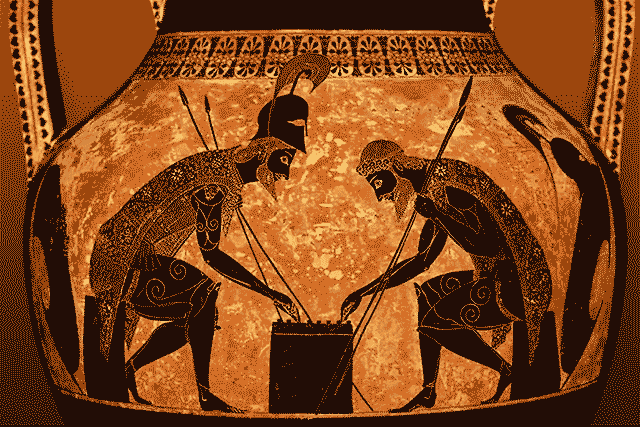
It is only fitting that humankind’s first true historian was a general and it just so happens he was a Greek. Thucydides of Athens was one of the ten “Strategoi”, the elected military leaders of the democratic Athens. When the Athenians lost an important battle in 422 BC, Thucydides was blamed for the loss and sent to exile. To serve for the Athenian democracy was in a certain sense not unlike serving under modern dictators: one “wrong” result could lead to banishment or even death. Thucydides, therefore, watched the great conflict between Athens and Sparta from the sidelines. Between 431 and 404 BC, both poleis fought a multidimensional war in which all Greek states and many of the neighbouring nations got sucked in. Sparta won in the end, but lost the following peace. The Greek poleis had lost so much blood, treasure, and will that they were no longer able to fight off the monarchies around them (like they did against the Persians in 490 and 480 BC).
For Thucydides there were three reasons for war: fear, interest, honour. Undoubtedly, this was a most insightful concept that holds truth till today.
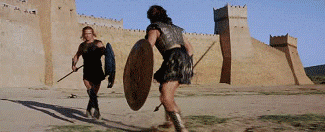
We owe a lot to the Greeks and Romans - not as much as many would like to think because of the impact of Western Christianity from where we draw much of our shared beliefs such as human rights and individual integrity (please read Cambridge educated classicist Tom Holland’s excellent book Millennium: The End of the World and the Forging of Christendom) - and it is rightly seen as one of the bedrocks of Western civilisation.
The university today and Western society at large has forgotten that history itself had begun with Herodotus and Thucydides as the story of armed conflicts. These so-called ‘dead white men’ actually teach us something about ourselves as individuals and as a society. And that is as Thucydides wrote, “War is a violent teacher.” Thucydides knew from personal experience that war could teach people to do terrible things.

There are many reasons why people are drawn to military history. People may feel drawn to military history because they wants to learn about virtues forged out of war such as duty, honour, and sacrifice (don’t laugh), or because of interest in technology or because of a pathological need to experience violence (more often than we care to admit), if only vicariously. The importance - and challenge - of the academic study of war is to elevate that popular enthusiasm into a more capacious and serious understanding, one that seeks answers to such questions as: Why do wars break out? How do they end? Why do the winners win and the losers lose? How best to avoid wars or contain their worst effects?
A peace time public illiterate about the conflicts of the past can easily find itself paralysed in the acrimony of the present. Without standards of historical comparison, it will prove ill equipped to make informed judgments.
It’s not that military history offers cookie-cutter comparisons with the past. Instead, knowledge of past wars establishes wide parameters of what to expect from new ones. Themes, emotions, and rhetoric remain constant over the centuries, and thus generally predictable. Athens’s disastrous expedition in 415 BC against Sicily, the largest democracy in the Greek world, may not prefigure the West’s war in Iraq. But the story of the Sicilian calamity does instruct us on how consensual societies can clamour for war - yet soon become disheartened and predicate their support on the perceived pulse of the battlefield.

Military history is as often the story of appeasement as of warmongering. The destructive military careers of Alexander the Great, Caesar, Napoleon, and Hitler would all have ended early had any of their numerous enemies united when the odds favoured them.
Indeed, by ignoring history, the modern age is free to interpret war as a failure of communication, of diplomacy, of talking - as if aggressors don’t know exactly what they’re doing. Margaret Atwood, a writer I do admire, once put it, “War is what happens when language fails”. This was a view echoed by many between the two World Wars. It was an argument popularised by historians such as AJP Taylor at the time. But we now know that not to be true.

For the easily triggered narcissist generation raised on woke popular culture, real life problems between states, like those in our personal lives, should be argued about by equally civilised and peaceful rivals, and so solved without resorting to violence and done in the spirit of inclusivity and diversity.
Yet it’s hard to find many wars that result from miscommunication. Far more often they break out because of malevolent intent and the absence of deterrence. To her credit, it was Margaret Atwood who would write in her poem: “Wars happen because the ones who start them / think they can win.” That’s it in a nutshell. Nothing fancy or intellectual or intersectional just a simple brutal truth: power trumps all. It was Hitler who put it in stark terms, “If you win, you need not have to explain...If you lose, you should not be there to explain!”
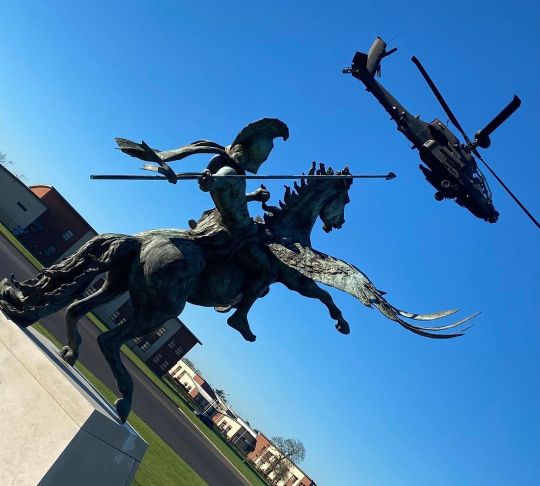
In the twenty-first century, it’s easier than ever to succumb to technological determinism, the idea that science, new weaponry, and globalisation have altered the very rules of war. But military history teaches us that our ability to strike a single individual from 30,000 feet up with a GPS bomb or a jihadist’s efforts to have his propaganda beamed to millions in real time do not necessarily transform the conditions that determine who wins and who loses wars.
True, instant communications may compress decision making, and generals must be skilled at news conferences that can now influence the views of millions worldwide. Yet these are really just new wrinkles on the old face of war. The improvised explosive device versus the armoured fighting vehicle (AFV) or the RPG rocket launcher against an Apache AH64 helicopter are simply an updated take on the catapult versus the stone wall or the harquebus versus the mailed knight. The long history of war suggests no static primacy of the defensive or the offensive, or of one sort of weapon over the other, but just temporary advantages gained by particular strategies and technologies that go unanswered for a time by less adept adversaries.
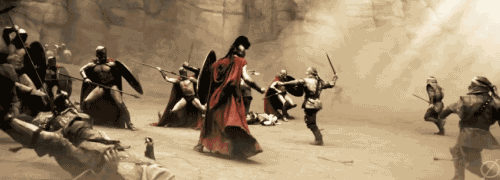
Military history reminds us of important anomalies and paradoxes. When Sparta invaded Attica in the first spring of the Peloponnesian war, Thucydides recounts, it expected the Athenians to surrender after a few short seasons of ravaging. They didn’t - but a plague that broke out unexpectedly did more damage than thousands of Spartan ravagers did. Twenty-seven years later, a maritime Athens lost the war at sea to Sparta, an insular land power that started the conflict with scarcely a navy. The 2003 removal of Saddam refuted doom-and-gloom critics who predicted thousands of deaths and millions of refugees, just as the subsequent messy four-year reconstruction didn’t evolve as anticipated into a quiet, stable democracy - to say the least. Hubris always goes before a fall.

Finally, military history has the moral purpose of educating us about past sacrifices that have secured our present freedom and security. If we know nothing of Hastings, Agincourt, Boyne, Trafalgar, Waterloo, Somme, Passchendaele, Battle of Britain, El Alamein, Imphal, Kohima, Falklands, and Helmand, the crosses in our military cemeteries are just pleasant grey stones on lush green lawns. They no longer serve as reminders that thousands endured pain and hardship for our right to listen to what we wish on our smartphones and to shop online in safety, and to protest for social grievances by desecrating statues - or that they expected future generations, links in this great chain of obligation, to do the same for those not yet born.
Most nations are born through war, reunited by war, and saved from destruction by war. No future generation, however comfortable and affluent (yes, that includes you from the safety of your ivory tower), should escape that terrible knowledge. I don’t enjoy saying that and I certainly don’t revel in it. I only say it because it’s what the span of human history teaches us and what my personal experience of the battlefield has been.

We must all abandon the naive faith that with enough money, education, or good intentions, we can change the nature of mankind so that conflict, as if by fiat, becomes a thing of the past. In the end, the study of war reminds us that we will never be gods. We will always just be men (and women), it tells us. Some men and women will always prefer war to peace; and other men and women, we who have learned from the past, have a moral obligation to stop them. Because if we don’t then something much worse will always meet us further down the line and we may not be able to stop them.
I don’t apologise for my less than rosy view of human nature but long before history littered the battlefields of Marathon and Thermopylae or Alesia and Canae with dead white males, we would do well to heed the words of Cormac McCarthy who wrote in Blood Meridian, or the Evening Redness in the West, “War was always here. Before man was, war waited for him. The ultimate trade awaiting its ultimate practitioner.”

Thanks for your question.
#ask#question#war#military history#western society#greek#roman#civilisation#human nature#human condition#british army#western civilisation#thucydides#personal#heraclitus#classical#history#society#culture
115 notes
·
View notes
Text
Originality, Criticism, and Entitlement
After joining the IF community, I've come to see (and experience) the accusation that there are IF writers who steal, copy, or even plagiarize another author's work. I'm going to explain why throwing such accusations around is harmful not only to the accused, but the community as a whole.
This is also an explanation as to why they're incredibly stupid criticisms, and unless there is actual, direct evidence that the work is being copied or stolen, it is not, as such "critics" want to call it, "ripping off" anybody.
(Long read)
Star Wars (1977) is considered by many to be the world's first real blockbuster, with such sensation and hype that even over thirty years since its original release date, it reminds a key figure in our pop culture and media today. In every form or fashion, Star Wars was groundbreaking in terms of cinematic storytelling and movie-going experience.
But Star Wars is nothing new.
George Lucas, the creator, has discussed many times over the years just how precisely the world of Star Wars came to be, and its origins go back much, much farther than you think.
George Lucas claimed that the idea of Star Wars was inspired by Flash Gordon serials, a comic book series that was turned into a TV show in the 1930s. The famous title crawl that appears at the beginning of every Star Wars movie?

Look familiar?
It is also a pretty well known fact that the Galactic Empire and Rebels, along with the battle scenes within the movies, also take heavy inspiration from WWII. Stormtroopers are German Gestapo, the X-Wings and TIE Fighters are inspired by WWII aerial combat: https://youtu.be/msb8OdvBBjU
There is a clear right and wrong that is written into the Star Wars universe, and that most assuredly comes from the material and real world events that George Lucas was inspired by; serial comics and shows of the 30s, 40s, and 50s, leaned heavily into black and white morality. This is why superheroes from that era like Superman or Batman were originally written as static characters. "Superman is invincible, that's not as interesting as the X-Men struggling with their place in society!" Well, yeah, that's because Superman was meant to be nothing more than a comic book character that allows children to act out their power fantasy- "you can't make me go to bed, mom! Superman doesn't go to bed!" etc. etc.
But Star Wars has inspiration that goes back even further than the 1930s. It goes back to ancient Mesopotamia.
The Epic of Gilgamesh is the world's oldest and most notable form of literature that we know of. It is an epic that describes the heroic journey of one Gilgamesh, told in five parts. This is the earliest known example of what is known as "The Hero's Journey" in literature.
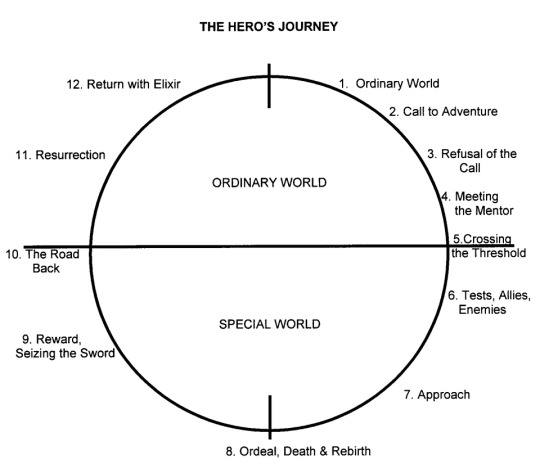
If you have any knowledge of the first movie of Star Wars, you're well aware of the story beats that you can read out in this diagram, as well be able to distinguish the similarities it has with The Epic of Gilgamesh.
Does this mean that Star Wars ripped off The Epic of Gilgamesh?
No. It doesn't. Because even though the story shares similar story beats, and features a black-and-white morality, a sci-fi space opera is a far cry from ancient Mesopotamian gods battling with each other. George Lucas didn't read the epic in school and decide "ah ha! I know how I'm going to make money!"
He was inspired, and he took that inspiration and created a multi-billion dollar franchise that millions love across the globe. He wrote that story and directed that movie, he put in the blood, sweat (lots of sweat- they filmed in Tunisia) and tears to make something WHOLLY NEW, and yet in some ways...similar.
Humans are very complex creatures, and our brain loves nothing more than finding patterns in things. Why is there such a thing as the Rule of Three in literature, a rule that dictates the satisfaction the reader gets when a story has a plot that occurs in three parts? Why is there traditionally only three acts? It is, simply put, satisfying. This traditional three-part structure often times creates stories that may look or feel similar simply because of how it is structured. This is not copying. This is a literature technique that humans have been using since the beginning of language itself.
And this is why I have such a problem with the people suggesting that authors are "copying" popular works- no one solely invented story beats, no one invented the supernatural fiction, no one, singular person, solely created the concepts that we are using today. No one. Not a single thing written is wholly original.
Originality is overrated. We are products of our environment, our culture, our media we consume- if an IF writer has a story with vampires and other supernatural creatures, and the MC is a detective attempting to solve crimes, was that invented by the very popular Wayhaven Chronicles by Mishka Jenkins? No. Vampires in media are nothing new, detectives in media are nothing new, and if they so happen to exist in other stories, what of it? Did Mishka invent vampires? No. They're a cultural phenomenon that has existed in multiple civilizations at once. Did she invent detectives? Obviously not.
Mishka was inspired and so were countless of other IF writers to write a story that involved the supernatural. These IF writers may have similar story beats, they may have similar themes, but that does not make it copying.
You know what makes Star Wars or The Wayhaven Chronicles or any other form of entertaining media great? Innovation.
It is how the authors tell the story, and why it is being written that creates such vast differences in genres. Star Wars isn't The Epic of Gilgamesh because its just "in space", it is the magnificent, innovative storytelling behind Star Wars that makes it so unique in our minds. The cinematography, the storytelling, the dialogue, the acting- all of that hard work into making something worthwhile and good is what makes it so unique when comparing it to other media that feature the literary use of "The Hero's Journey".
We all have something to bring to the table, to tell our stories that have a piece of us inside them. They are influenced by our laughter, our tears, our horror, our love, our rage or terrible indifference. They are influenced by our passions, our delusions, and they are written because we wish it to be so.
Are all impressionists copying Monet because he popularized impressionism? Are all artists who paint in similar styles copying off of the one who created the style in the first place? No. They're not.
To accuse IF authors, particularly the INNOCENT ones of copying others is an unbelievably insulting and ignorant statement that disregards the author's creativity and free will to write whatever the hell they want. If all you have to see out of a story is the basic, bare bones elements to it, then allow me to speak for all IF authors out there and say:
You're missing the fucking point!
We've all put our hard work into not only LEARNING a coding language (which, surprise, not ALL of us know and have to spend HOURS figuring out) but we've learned a coding language to create a game for other people to enjoy, and we'll be damn fucking lucky if we're able to get any money off of our work that we have put in it.
This criticism becomes a form of entitlement real fast, as if a reader has any say as to the pace or way an IF story (or any art for that matter) is written.
Most of us are doing this because we love the idea of putting our work out there as an IF fiction for fun. Some of us have to work jobs, some of us have complicated lives that demand constant attention, some of us wish to do this as a living, but all of us?
All of us deserve the courtesy of being a creator that is sharing their work with the world.
The next time you decide to accuse an IF writer of copying another person, ask yourself if it's legitimate plagiarism or you're just someone who doesn't have the capacity to consider that literary themes, tropes, cliches, and genres, are not the same thing as "copying".
268 notes
·
View notes
Text
Pagan vs Christian Worldview || 4 HUGE Differences
youtube
One of the most common questions I receive is if someone can be both Christian and Pagan. This is a difficult question as it depends on what perspective you're coming from. From a Christian perspective the answer is definitely NO as in Christianity you must only believe in the one ‘true’ God. If you’re looking from the Pagan perspective the idea of combining Christianity & Paganism is a bit more possible because as Pagans we can always add on an additional deity, which in this case would be the Christian God, into our religious practice. However, there are some huge differences between the Pagan & Christian lifestyle and worldview that would make combining these two faiths difficult. So for this video & blogpost I want to share what I view makes the Pagan worldview so fundamentally different from Christianity.
Now before we begin, some disclaimers. I am not an official expert on religion. This is just my personal understanding of the differences between Paganism and Christianity so take everything I mention with a grain of salt. I understand that there is complexity and nuance to everything and this is just meant to be an introduction & my personal beliefs. This is also a very difficult topic to tackle because Paganism is an umbrella term and there are many different religions with varying beliefs and practices that could be considered Pagan. For the purposes of this post I’m using commonalities I find among the majority of Pagan religions, though this will of course not reflect all Pagans or Pagan religions.
Now that we got that out of the way here are 4 fundamental differences between Paganism and Christianity:
One God vs. Many Gods
In Christianity there is belief in one true god. Those that believe in this God will ascend to heaven and those that believe in either multiple deities or a different singular God are incorrect and they must be “saved” or else they will not ascend to heaven. In Paganism we believe in multiple Gods. While there may be a hierarchy of Gods, with some more powerful than others, the belief in multiple deities is an essential part to Paganism.
This makes Paganism distinctively different from Christianity and also makes it extremely versatile as each individual can choose the deities they would like to incorporate in their religious practice. This Pagan worldview also allows for religious syncretism which is the blending of two or more religious belief systems into a new system. The deity Hermes Trismegistus is an example of this as he is a deity formed by combining the Greek god Hermes and the Egyptian god Thoth.
Why is Religious syncretism important? Well, Pagans have the ability to adopt other deities and religious customs instead of completely rejecting them as wrong or sinful. Because of this unique feature it is my personal belief that Paganism is very conducive to peacefully living in a society that is filled with a diversity of people with various faiths. Also, as a side note, since there is not ONE true God in Paganism that means that others don’t need to be “saved” so there is no need to proselytize in Paganism. “Spreading the word” or converting others is not necessary or desired in Paganism.
Faith vs. Actions
Faith is the most important aspect of Christianity. Sin can be forgiven as long as you confess & have faith in the one true God. For example, in Hebrews 11:6 “And without faith it is impossible to please God, because anyone who comes to him must believe that he exists and that he rewards those who earnestly seek him.”
In most Pagan societies, faith was secondary to actions. It was more important to perform the rituals & festivals to honor the Gods than it was to fully believe in the Gods. It was your actions in life, not your faith, that determined your place in the afterlife. You can look at Valhalla as an example - it was your strength in battle, not your faith, that determined a place in Valhalla.
You can also look towards ancient Roman society where religion was practical and contractual, based on the principle of "I give that you might give." Roman religion depended on knowledge and the correct practice of prayer, ritual, and sacrifice, not on faith or dogma. Excessive devotion or fearful groveling to deities was considered undignified in Roman society. This does not mean that faith was unimportant among Pagan societies, it just means that it was not valued in the same way as it was within a Christian worldview.
For example, we can look at a quote from Marcus Aurelius’ Meditations, “Since it is possible that you might depart from life this very moment, regulate every act and thought accordingly. But to go away from among men, if there are gods, is not a thing to be afraid of, for the gods will not involve you in evil; but if indeed they do not exist, or if they have no concern about human affairs, why would I wish to live in a universe devoid of gods or devoid of Providence? But in truth they do exist, and they do care for human things, and they have put all the means in man’s power to enable him not to fall into real evils.”
Here Marcus Aurelius is stating how the Gods have created us not to watch over us to see if we are sinning, but instead they have empowered us to create and mold our own lives. Faith here is not what’s truly important. What’s important is the quest to empower ourselves to actions that better our lives and the lives of others.
Mercy vs. The Warrior
In Christianity there is a focus on humility, peace, and meekness and an de-emphasis on physical strength & the warrior archetype. For example, Matthew 5:5 - “Blessed are the meek, for they shall inherit the earth.”
This is much different from Paganism. There is not a ‘turn the other cheek’ worldview and Pagan societies were not always peaceful or gentle. In fact, pretty much every Pagan society had at least one God of war.
This does not mean that we as modern pagans condone violence. However, it does mean the warrior archetype has value and that building both physical & mental strength can be an active part of Pagan practice. If you are interested in learning more about the Warrior archetype I would recommend watching the video The Archetype of the Warrior – How Films Help Empower Us All.
Strength in the Pagan worldview, both personally & collectively as a society, was greatly important. For example, you can consider the value of athletic glory in Ancient Greece or you can look towards Socrates who wrote, “No man has the right to be an amateur in the matter of physical training. It is a shame for a man to grow old without seeing the beauty and strength of which his body is capable.”
In Paganism the body is not sinful nor is it something to be ignored. In fact, the body is an integral part of spiritual practices. Through bodily strength & pleasures we gain access to glimpses of the divine, but that does not mean we should descend into purely hedonism. There is of course a time & a place for hedonism in Paganism, but it must be balanced by a strong body and mind.
Focus on Afterlife vs. Focus on Life
In a Christian worldview the goal is to live in faith without sin so that you may ascend to heaven. In many Christian texts and in certain aspects of modern Christian culture there is a yearning for this life to end and for the rapture to occur. During this time faithful Christians will be chosen by God and the rest of us will descend to hell for eternity.
Even the main symbol of Christianity, the cross, focuses on death and the afterlife. Additionally, you have the concept of the martyr - to sacrifice your life for God leads to sainthood.
By contrast, the afterlife is not as important within Pagan societies. While there are some occasional mentions of places like Elysium or Valhalla, it’s clear that the afterlife was not a main focus of Pagan religions. Instead, a main focus of Pagan religious rites and festivals was to celebrate life & fertility. This celebration of fertility is a clear departure from the Christian worldview.
In Christianity, female sexuality and fertility is often viewed through a lens of sin. Pagan societies however, greatly celebrated fertility - both our human fertility and the fertility of the land. Some of the earliest art we humans created, like the Venus of Willendorf, emphasized the sexuality & fertility of the female form and celebrating this fertility is an integral part of pretty much all pagan religions.
When it comes to death in Pagan societies, it was your legacy that mattered much more than where you end up after you die. For Pagans achieving eternity did not mean dying and going somewhere where you’ll live forever. Instead eternity was achieved when the great acts you performed in life are remembered & retold by your descendants and your community.
There’s a lot more I could discuss about the differences between the Christian & Pagan worldview, such as Purity of God vs Flawed Gods or the Intersection of Science and faith in Christianity & Paganism so let me know if you enjoyed this post and I maybe I will make a part 2.
Next I’d love to hear what you think are some of the fundamental differences between Christianity and Paganism, so please share your thoughts as well. ✨
#paganism#witch#witchcraft#witchblr#pagan#Pagans of Tumblr#witches of the world#Christianity#Heathen#baby witch
59 notes
·
View notes
Photo

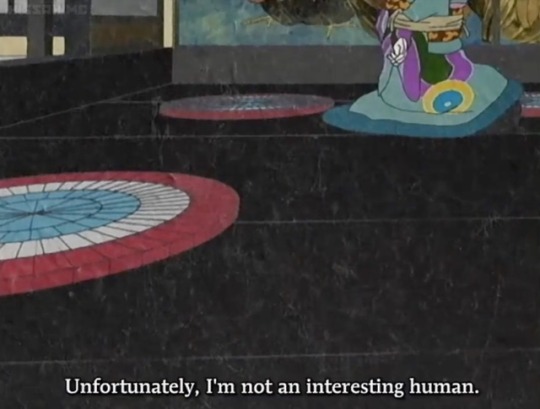
What is the Medicine Seller?
The subjectivity of Mononoke is a large part of what makes the series unique. But, one of the biggest mysteries that the show leaves unanswered is what exactly the Medicine Seller is supposed to be. From his weird powers, traits, and appearance to the fact that he clearly doesn’t age, it’s an understatement to say that this isn’t a normal guy. All kinds of theories have been floating around about the Medicine Seller’s true identity, that he’s a onmyōji, a god, or some kind of benevolent mononoke.
However, for my money, looking at all the evidence combined from the show and Japanese mythology, I’ve concluded that the Medicine Seller is most likely a kitsune.

Now, I feel like most anime viewers have at least a cursory idea what a kitsune is, but just to recap: “Kitsune” (狐) is the Japanese word for fox. Traditional Japanese folk beliefs attributed all sorts of mysterious powers to foxes, including shapeshifting, creating illusions, and warding off evil spirits. Taking cues from ancient Chinese lore about fox spirits, kitsune have captured the imagination of Japanese artists and storytellers for centuries and continue to do so in the present day.
I’m far from the first person to come up with the “Medicine Seller is a fox” theory. It’s the only theory cited on the admittedly bare-bones Mononoke Wiki, and numerous commentators and Tropers have speculated that our favorite flamboyant exorcist might be a fox in disguise. So, allow me to take some time to display all the compiled evidence as to why I think this is the most plausible theory.
Let’s start with the obvious: The guy looks like a fox.
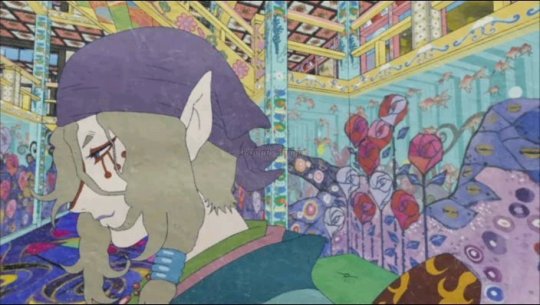
The red markings on his face are very reminiscent of the red paint you see on the traditional kitsune masks people wear around festival time. These markings are highlighted in the anime’s opening, so you can really see the similarity.

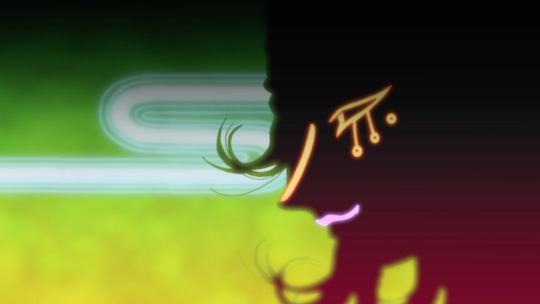
His long ears and fangs could also be considered vulpine.
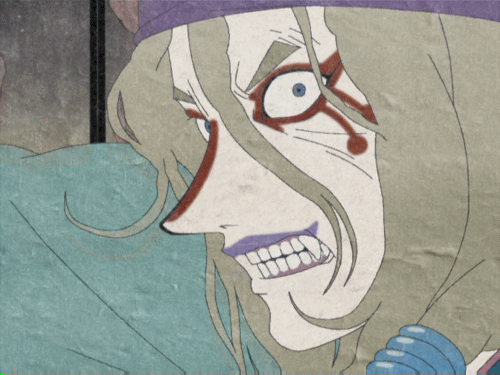
The literature is rife with examples of foxy traits showing through a kitsune’s human disguise, especially when they’re startled or caught off-guard, such as ears, a tail, or canine teeth. We’ve never seen a tail on the Medicine Seller, but who knows what he’s hiding under that robe? I’ve also seen some sources claim that the tail will be revealed if you see the kitsune’s reflection or shadow. We haven’t seen either, so who knows?
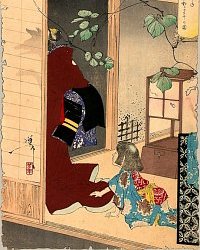
Secondly, there’s a hierarchy to keep in mind when thinking about Japanese foxes. Some kitsune are holy messengers while others are malignant spirits that bring ruin to humans. Some are merely pranksters, using their powers to pull hilarious tricks on unwitting humans, sometimes to teach them a lesson but often just for shits and giggles.
Holy, high-ranking foxes are said to be messengers of the Shinto god Inari, the rice god and the patron deity of merchants and sword smiths.
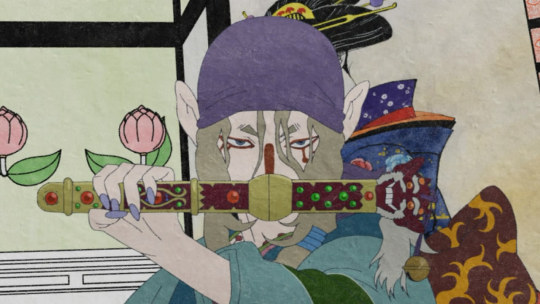
Pictured: A merchant with a sword.
Fox statues like the one pictured above can be seen standing guard in front of Inari’s shrines, where they are said to ward off evil. The A-to-Z Online Buddhist dictionary has this to say:
“[T]he fox is associated with the concept of Kimon 鬼門, literally “demon gate,” a Japanese term stemming from Chinese geomancy (Ch: feng shui). In Chinese thought, the northeast quarter is considered particularly inauspicious. It is the place where "demons gather and enter." This belief was imported by the Japanese and is referred to as Kimon. Kimon generally means ominous direction, or taboo direction. In Japan, the fox is considered a powerful ally in warding off evil Kimon influences. Fox statues are often placed in northeast locations to stand guard over demonic influence, and two foxes typically guard the entrance to Inari Shrines, one to the left and one to the right of the gate.”
He may not be a statue, but “warding off demonic influences” is basically half of the Medicine Seller’s job description. He often uses seals, salt, prayer, and other methods accessible to humans, but the Bakeneko arc of Ayakashi clearly shows he can keep a mononoke at bay just by flexing really hard.
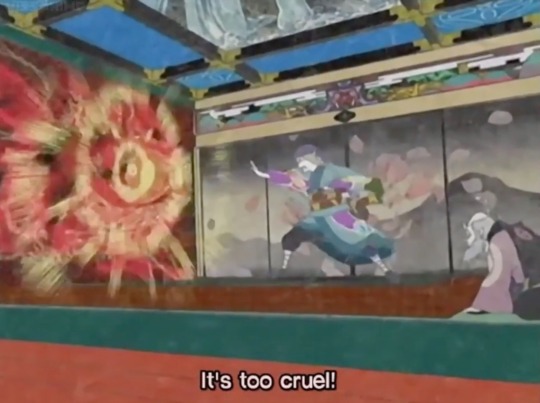
Yokai.com goes into some detail about the various ranks of kitsune, from the lowliest trickster to the most divine guardian. One rank of kitsune of particular interest to me is called the Kiko (気狐), a servant of Inari that has evolved to the point where it no longer has a physical form. Many Kiko adopt human disguises, but they have not yet ascended to a heavenly plane and so remain on Earth serving Inari’s will.
We have never seen the Medicine Seller eat, drink, or sleep. There is, however, one physical need that he does indulge in.
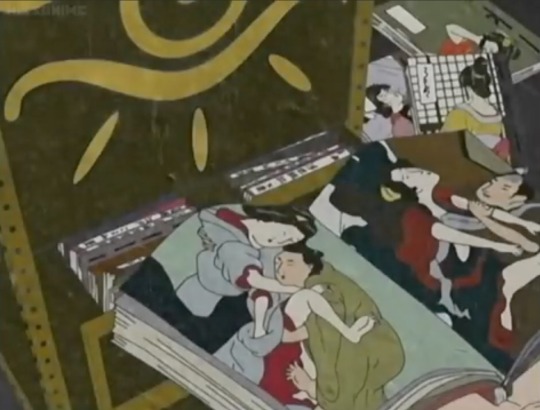
If you get my meaning.
Pictured above is the Medicine Seller’s extensive shunga (春画) collection. Shunga is Edo period porn, and it wasn’t exactly uncommon for merchants to be carrying volumes of shunga on their person. However, 20+ volumes seems a bit excessive to me.
It’s a trait that doesn’t come up all that much in Mononoke, but the first episode of Ayakashi’s Bakeneko arc reveals that the Medicine Seller is a bit of a horny bastard. He trades info on various virility and fertility medications with Kayo, a conversation that involves a lot of whispering into her ear. He was about to share his porn with Kayo before they were interrupted. I’m convinced that if Sato had entered the kitchen ten minutes later, she would have found the two of them fucking on the floor.
As anyone who's watched Naruto can tell you, kitsune are often associated with sex. Inari, among other things, is also a fertility god, and there are many stories of kitsune adopting human form and seducing unwitting mortals, running the full gambit from the horrific to the romantic. A good chunk of these stories involve the kitsune marrying their human beau and even bearing his children in some cases.
Most stories of this nature center on female kitsune, but it’s not like male kitsune don’t exist. The popularity of sexy fox women can probably be chalked up to male-dominated Edo society, but more and more male kitsune have been sighted in modern anime.


I believe we can add Mononoke to this number. Practically every woman in the series creams their pants at the mere sight of the Medicine Seller, and it doesn’t seem that their attraction is one-sided. The Medicine Seller has all kinds of sexual tension with Kayo in both series. And, if you look closely, you can spy some romantic tension with Ochou as well. There’s little doubt that the Medicine Seller is attracted to human women and is even capable of falling in love with them. However, due to his role slaying mononoke, it is unlikely that he can ever settle down and marry one the way many other kitsune do.


Personality-wise, the Medicine Seller is also reminiscent of a fox. Like I mentioned above, kitsune are often tricksters by nature. Although the Medicine Seller never acts in a needlessly malicious way, he does like to dick around with people. A lot of the aforementioned tension with Kayo takes the form of teasing banter.



Keep in mind: It wasn’t him who changed the compass. Which means he’s being vague for no other reason except to mess with Kayo.
He also spend a good portion of his arc in Ayakashi trolling the Sakai household, especially Odajima. And do we even need to mention his gambit in the Nue arc?
youtube
So, his appearance, relationships, and personality are all decidedly fox-like. What about his powers? Well, in the Nopperabou arc, we get a pretty clear hint that the Medicine Seller’s physical form is just an illusion.

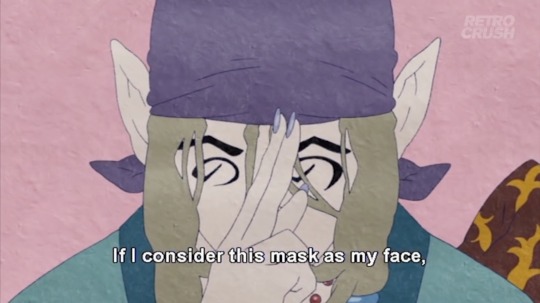
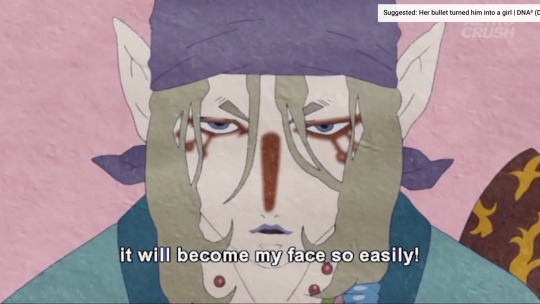
The Masked Man’s attempt to take away the Medicine Seller’s face failed because that wasn’t his real face. He outright compared his face to a facade. Since it was just an illusion, it was easy for him to change it back. It should also be noted that the Nopperabou, the faceless ghost, often appears not as an independent spirit but a hilarious prank that other yokai like to pull on humans. Tanuki, Manji (badger spirits), and, yes, even Kitsune have used the image of a faceless human being to scare humans. This is getting into fan wank territory itself, but it is entirely possible that the Medicine Seller is all too familiar with the art of face removal, having pulled that trick himself in his younger days.
That the Medicine Seller’s body isn’t real could also explain the nature of his Other Self. During his first transformation sequence in Ayakashi (which is repeated in the Nue arc), we see the markings on his face and robes disappear.
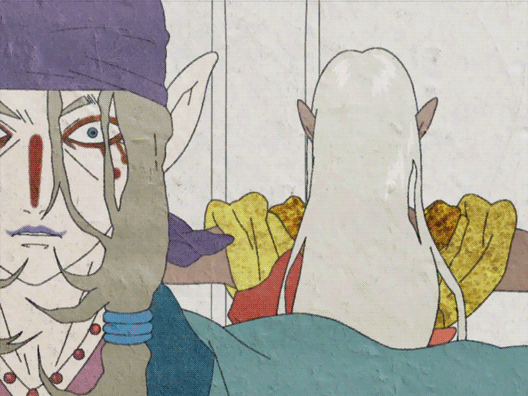
Before gold markings reappear on his Other Self.
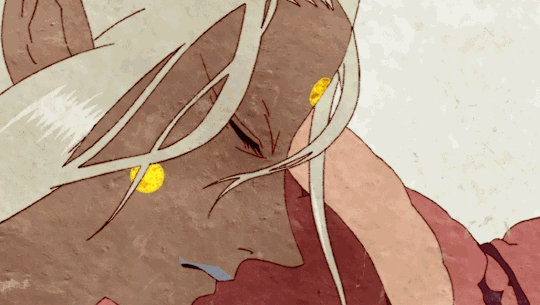
It might be possible to think of this “transformation” as more of a body surf. The flowing markings could indicate the presence of the fox spirit as it moves from one body to the other. This is a good time to point out that gold eyes are said to be another common trait of kitsune, and white fur is indicative of an Inari fox. The Other Self’s long white hair may be a hint as to his divine nature.
Now, with all his powers and religious motifs, is it possible that the Medicine Seller is not a fox but in fact Inari himself? I did briefly contemplate that possibility, but I ultimately decided it probably wasn’t true. The Medicine Seller’s powers have limits that I feel a high-ranking god like Inari wouldn’t have. It looked like he did serious damage to himself trying to hold back the bakeneko in Ayakashi.
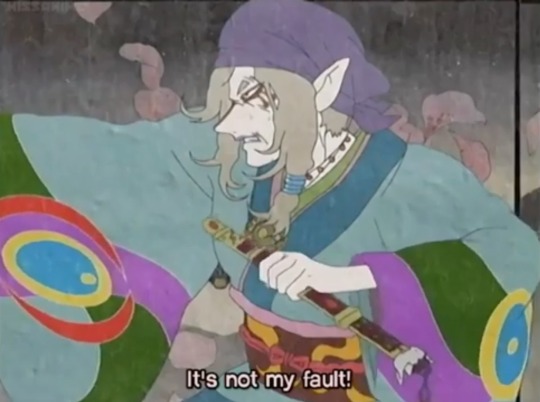

Ouchies.
Rather than being a human avatar of Inari, I find it more likely that the Medicine Seller is a kiko carrying out Inari’s will. In his first appearance in Ayakashi, some men spot the Medicine Seller standing outside the Sakai household, apparently talking to himself.
At the beginning of Mononoke’s first episode, he does the same thing outside the inn. His mouth is moving, but we don’t hear what he’s saying.
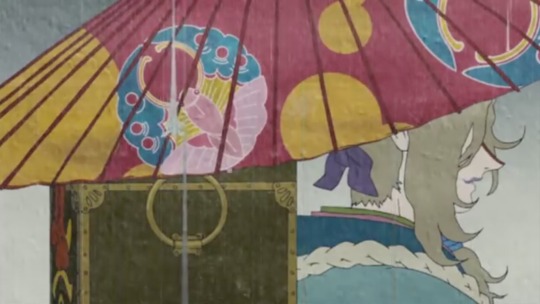
In both cases, the men who see him try to call out to him to get his attention, and in both cases he ignores them. He never says who he was talking to, and nobody ever asks. It is strange, however, that he always shows up just where a mononoke is going to be, even when he doesn’t seem to know anything about the mononoke before he arrives. Could it be he is actually receiving instructions from Inari? Inari might be telling him where to go, and the Medicine Seller figures out the rest from there. He can’t know about the mononoke’s form, truth, or reason yet, otherwise he’d be able to slay it right away. How else would he know where to go unless he was being told?
Of course, there are other possibility as to who he could be talking to. It could be his Other Self, if you hold the theory that the Medicine Seller and the Other Self are separate entities (which I don’t, so much). I also contemplated whether it was the sword he was talking to, but the sword is in the trunk. For my money, communing with a god seems the most fitting.
According to Shinto beliefs, foxes can live for up to 1000 years, which would explain why the Medicine Seller is still around after centuries have passed. But, what happens after the millennium is over? At that point, a kitsune sprouts its final, ninth tail and ascends to the heavenly plain, leaving this earth behind. I personally believe that the Medicine Seller has been tasked to wander the earth for 1000 years, slaying mononoke until his time is up. At that point, he’ll become a being as powerful as a god, but until then he must learn to truly understand humanity. Only once he has become thus enlightened will he be able to ascend.
This, I believe, is why the Sword of Exorcism can only be drawn once he’s learned the mononoke’s form, truth, and reason. He can only slay the mononoke if he comes to truly understand it and sympathize with it. It’s all part of a thousand-year long learning process in addition to aiding humanity.
And once he’s done, some day centuries from now, perhaps another young fox will take up the sword and walk through man’s despair, putting the souls of the anguished to rest.
It’s a lonely destiny, but it has its perks.
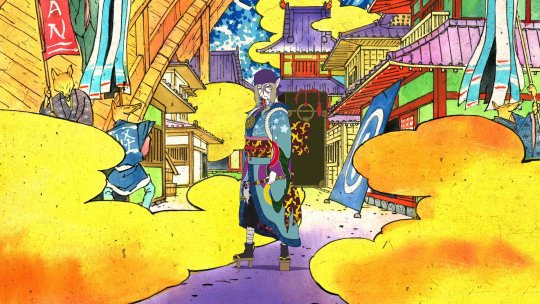
頑張ってね。
#mononoke#medicine seller#kusuriuri#theory#kitsune#fox#shinto#inari#ayakashi samurai horror tales#headcanon
664 notes
·
View notes
Link
In “Why the Jews?” my book on anti-Semitism, there is a chapter on anti-Americanism. My co-author, Rabbi Joseph Telushkin, and I long ago understood that many of the reasons for Jew-hatred and America-hatred were the same.
Among them are envy of success — material, of course, but even more importantly, success in terms of influence. Another is the religious foundation of both peoples: Both America and the Jews are rooted in a belief in God, a belief they are a Chosen People and belief in the Bible, especially the Old Testament, as the book from which they derive their values.
America-haters and Jew-haters resent the enormous influence both nations have had on the world, have contempt for their belief in being Chosen, and dismiss the Bible as irrelevant and even malevolent.
In the premodern age, Christian anti-Semitism was primarily animated by the charge of deicide — the charge that the Jews killed Christ, a charge that does not have a parallel in anti-Americanism. But beginning in the 20th century, the reasons for the two hatreds converged.
In his recent biography of Adolf Hitler, Brendan Simms, a professor of the history of international relations at Cambridge University, identified Hitler’s hatred of America and especially of capitalism as central to Hitler’s worldview: “Hitler’s principal preoccupation throughout his career was Anglo-America and global capitalism. … Hitler wanted to establish what he considered racial unity in Germany by overcoming the capitalist order and working for the construction of a new classless society.”
In other words, another commonality of America-hatred and modern Jew-hatred has been hatred of capitalism. The Nazis hated America and the Jews, both of whom they identified with capitalism. And the left (not the liberal, who traditionally loved America, but who has become the primary enabler of the left) hates America, which it regards as the paragon of capitalism. By becoming the most successful country in history, America, the quintessential capitalist country, remains a living rebuke to everything the left stands for. If America can be brought down, every left-wing egalitarian dream can be realized.
The question for the America-hater, just as for the Jew-hater, has been: How do we destroy them? What has always rendered anti-Semitism unique among ethnic and religious hatreds was its goal of extermination. No other ethnic bigotry is exterminationist. Regarding America, the left does not seek to exterminate Americans; the idea is ludicrous since most of those on the left who loathe America are themselves American. What the left does very much seek is to destroy America as we have known it — the capitalist and Judeo-Christian enclave of personal freedom.
The Jews created something world-changing by introducing into the world the Hebrew Bible, a universal and judging God, the Ten Commandments, the rejection of the heart as the guide to behavior, the emphasis on justice (not “social justice”), and the doctrine of Jewish Chosenness. They were forever hated for this. So, too, is America hated for placing the Bible at the center of its value system, its belief in being a “Second” Chosen People, its freedoms, and its capitalism. America is not hated for its slavery. If it were, given the ubiquity of slavery throughout world history, every country and ethnic group on the earth would be hated. America is hated for its values and its success.
The fact is that, just as did the ancient Jews, the Americans made something unique: the American experiment in freedom. And it succeeded beyond even its founders’ dreams. With all its faults, America did become a shining “city on a hill” — the famous phrase first articulated in 1630 by John Winthrop echoing Jesus in the Sermon on the Mount and repeated throughout American history. For example, President Ronald Reagan, in his 1989 Farewell Address, said, “I’ve spoken of the shining city all my political life.”
And who created this unique place of liberty, opportunity, and unequaled, widespread affluence? More than any other group, it was the WASP, the White Anglo-Saxon Protestant. I say this as neither Anglo-Saxon nor Protestant. Catholics, Jews, nonbelievers, and members of every faith, ethnicity, and race (blacks, in particular) made major contributions; but it was the WASP, more than any other group, who made America. And for that reason, America-hatred is WASP-hatred and, more broadly, white-hatred.
The idea that whites’ unique achievements — in making America, in music, art, literature, and the sciences — means that white people are intrinsically superior is absurd. Hitler was also white, as was Joseph Stalin, as are most American mass-murderers. Those facts are no more a commentary on whites than Johann Sebastian Bach or Leonardo da Vinci being white is a commentary on whites.
Whites made the country and the greatest civilization — not because they were white, but because of the values they held. Hatred of the white is ultimately hatred of those values.
Given what the WASP has achieved in the West and in America, it takes extraordinary levels of dishonesty and ingratitude to be anti-white. But neither truth nor gratitude is a left-wing value.
This column was originally posted on Townhall.com.
1 note
·
View note
Text
Mando’a Conjugation Tangents Because My Brain Got Lost
AKA: A Study of Ancient Mandalorian Culture and Society and the Development of Mando’a by Dissecting a Bunch of Words in a Bid to Find the One (Which I Don’t Find, but That’s Okay)
Um. So, I got carried away?
It started with me creating a clone oc: Clone Commander Alloy. I love creating fun nicknames for my characters, and I thought it would be cool to give him a nickname in Mando’a. I thought: Hey, ‘alloy’ is close to ‘ally’, so maybe one of his close friends/vod call him tomad: ally. Cute. Then I thought, but what about ‘alloy’ in Mando’a?
(You can jump to the very end for the TL;DR)
Cue me realizing there isn’t a straight translation. Cue me realizing there’s only one (1) metallic element given any sort of name in Mando’a: beskar, which is Mandalorian iron made of a metallic alloy (steel, which itself is an iron alloy, hence Mandalorian iron).
Cue me wanting to dissect the word beskar to figure out where it comes from.
After fighting with my brain for an hour, I finally just made it simple: since beskar is a confirmed alloy of which iron is the major part, then I just need to identify which part of the word is ‘iron’. Easily said and done if one considers that be means ‘of’ in Mando’a, leaving skar to mean iron. (I also cross referenced the Mando’a dictionary to make sure there weren’t any other words composed of skar as a word fragment in any form; it’s not). Literally translated then, beskar means ‘of iron’ which makes sense considering it’s an iron alloy - an alloy made of iron. Thus beskar transliterated is ‘alloy of iron’.
Now I want a word for ‘metal’, because ‘iron’ is too specific to be the only related word in Mando’a.
I started by looking for ‘forge’, like a blacksmith forge, thinking it might hold a clue. It didn’t. ‘Forge’ in Mando’a is actually nau’ur kad: lit. light up a sword. And, like, I can see where that’s coming from? But it’s more poetic than functional. This is when I recall the word goran: blacksmith, metalworker.
Cool. Okay. ‘Metal’ is included in ‘metalworker’, so I might be a step closer. Unsatisfied with the poetic version of forge, I decide I want a single word that means something closer to what ‘metalworking’ implies; I turn goran into a verb by adding -ar, making it goranar: metalworking, and call it good.
But I still want to isolate ‘metal’. Alright, so what part of goran is ‘worker’? Turns out that borarir is worker, and it’s base is bora: job. Instead, goran might come from gotal’ur: make, create/ gotal: made, created (an ‘-ized’ suffix). This is cool because tal means blood, so the Mandalorians seem to believe that to create something is very symbolic/ritualistic (like putting your blood, sweat, and tears into something).
(Kay. Taking the Mandalorian culture into account, it would seem that they would have definitely practiced metalworking as an artform, right? Historically, only the nobility had swords because only they had the time to learn how to properly use them, and we’ve seen that the Mando’ade who aren’t soldiers are often agriculturalists. Yet kad is still a known word, and beskar is basically a deity. It would make sense that, in their development as a culture/society, metalworking would have been way big especially as an art form (I look back at the p o e t i c term for ‘forge’ as an example). It then stands to reason that there’s no reason why the words I want to create don’t exist. They’re just... buried. Deep. Just throwing that out there so I seem less crazy lmao.)
Now, I would think that ‘metal’ would be something close to ‘iron’ considering, logically, there would be a word for ‘metal’ first and then iron later as it was found to be the superior metallic element, especially in alloy form. Kar shows up in a few words, like kar’am: breath, kar’ta: heart, kar’tayl: awareness, knowledge, and kar’taylir: know, hold in heart. As far as kar’ta goes, ta is obviously derived from tal for blood. The am in kar’am is ‘change’. Taylir is hold, keep, preserve. Comparing with mandokar (which we should all know the meaning of by now, it’s used so. often), we can assume that kar either has something to do with the ‘self’ or is more an indication of something personally/culturally/spiritually precious (not the soul, though; colloquially, manda is used as ‘soul’). Furthermore, kar seems to be used in words where emotion is involved (like, 9.5/10 times).
Personally, I think that kar could mean ‘iron’. Think about it: ‘iron change’ or the ‘change in iron’ to indicate breath just like how different levels of oxygen within the metal itself would affect quality. ‘Iron blood’ which, like, duh, but they wouldn’t have had the tech at the time to know human blood contains iron; they would have just compared the red of rusted iron to the color of blood, which, still cool. Mandokar would then be ‘an individual of/containing iron’ which fits with the definition.
Now, I can’t really get behind the fanon definition of kar being ‘star’. I can’t, because Ka’ra is ‘stars; ancient Mandalorian myth - ruling council of fallen kings’, so I would think ka would be ‘star’ and ra derived from the short list of words that start with ‘ram-’: ramaanar: die (general term), ramaanla: mortal (in the sense of fallible or vulnerable), ram’ika: raid, ramikad: commando, ramikadyc: commando state of mind, ram’or: attack, beseige, ramorla: beseiged, and ramser: sniper, marksman. Considering ika is a known diminutive, ram probably boils down to ‘battle’ or ‘war’ or something similar. Ka’ra then, would literally be something like ‘warrior stars’ - the great warrior kings of the past.
Back to to beskar, then, which I can actually keep breaking down. In the dictionary is bes’bev: Mandalorian wind instrument also used for combat, a large metal flute with a sharpened, cut-off end. Knowing that laar is song and bes’laar is music, but also knowing that a defining feature of pure beskar is the ringing sound it makes when hit against more pure beskar, and bev: needle, spike, and considering my ‘metalworking as art’ theory, I can see where bes’bev comes from for sure, especially if we assume beskar as a word was created first so that bes could be used to indicate the sound of the metal-strikes.
(Fun Facts: laar shows up again only in galaar: hawk, jai’galaar: shriek-hawk, the two conjugations of laar that give us ‘singing’ and ‘sing’, and werlaara: myth (archaic). Now, jai- comes from jair: scream, shriek, so that word’s self-explanatory. But werlaara is cool, because wer is archaic for ‘eon’, and laara would be the conjugated form of laar once again. From this we catch a glimpse of ancient Mandalorian culture - namely, the way they told stories: using music. Just thought that was supper cool.)
That still doesn’t really help me except just show where other words branched off. So. Square one (1): beskar breaks down into be: of and skar: iron. I would think the ‘s’ comes from the word for metal, especially if iron specifically, using the kar as an indication of strong emotion, is extra important as a metal to the Mandalorians. Based on the words I could find, the best match seems to be eso: flank, side. (Think of how the metal would have been used as armor to protect their flanks/sides). Look at bes; look at eso. I think metal might have been beso, because they would have used metal for armor before they ever used for art considering their warrior-clan history (again, in my head). So, beso: metal.
Back to goran, ‘cause I think I’m on to something here. So, the closest to ran I could find was rang: ash. Considering the role that ash actually plays in forging metal objects, that makes a lot of sense to me if goran is a metalworker/blacksmith. If I think about how ne’tra is ‘black’, it’s not inconceivable that the ‘ra’ in goran is actually derived from that (again, ran means nothing by itself, and ra is ‘or’). The ‘n’ is most likely just tacked on bc why not and to make it a noun. That just leaves go which seems to have a direct link to whether the word is about creating/making something or not. Conclusion: go: the shaping of something.
In the end, I couldn’t pin down a specific word for ‘alloy’, but I might get there someday. Thoughts? Sorry for the rambly-ness of this whole thing. I leterally was typing this up as the thoughts hit lol.
TL;DR:
beskar: alloy of iron (from be: of and assuming kar: iron)
goranar: metalworking
kar: a uniquely Mandalorian word used to indicate extreme emotional/spiritual importance to the subject; iron
ka: star
bes: a uniquely Mandalorian word that indicates the equally unique sound made by hitting two pieces of pure beskar to together
beso: metal
go: the shaping of something
#mando'a#more language#meta#star wars#language meta#mandalorians#mandalorian meta#thoughts?#star wars meta#sw#sw meta#sw headcanons#disregard of fanon
3 notes
·
View notes
Text
Headcanon; Time/Location of Agrabah
Ever since I started roleplaying Cassim back in 2014, I’ve been obsessed with ancient/post-classical Middle East & the Islamic Golden Age. Years later, I’m still researching. In the process, I became a lover of Arabic music, history, culture... & I’m also constantly raging at Sims for not having better Middle Eastern representation in their game. Seriously, wtf. Anyway, moving on... I’m not claiming this headcanon to be ACCURATE. I know some people like to place the time period during the Ottoman Empire & while I can see how that could work, I think my placement makes a bit more sense. The Ottoman Empire wasn’t as accepting of polytheistic beliefs during their reign & clearly, we see lots of proof of that in the movie/series. I mean, I’m no history wizard. This is just based on my personal research & observations from the movie/series. If you disagree with something, feel free to chime in. Time Period: 762 - 980 CE, Abbasid Caliphate Location: Baghdad (Agrabah) & the surrounding empire (Seven Deserts) Fun side note: Agra (city in India) & Baghdad (city in Iraq)...combined together, they make ‘Agrabah’.

Why 762 CE specifically? This was the year that the city of Baghdad was founded near the Sasanian capital city of Ctesiphon. Persian customs had been broadly adopted by the ruling elite, since the Sassanid empire had just ended in 651 CE. Persianate culture was a mixture of Persian & Islamic cultures that eventually underwent persification & became the dominant culture for centuries to come. During this point in time, Islam was on the rise, but was also co-existing with the traditional Persian religion- Zoroastrianism, as well as Hinduism, Christianity, & Judaism. Ethnic identities ranged from Arab to Persian & Turkish to Berber. This may be why we see multiple ethnicities & religious beliefs coinciding throughout the series. It varied between kingdoms, but some religions may have faced persecution. They were not, however, rejected. During this time, the empire stretched from the edges of India to the borders of Europe. This may also explain why Agrabah displayed a melting pot of people. Why not BEFORE the 7th century? Because the position of ‘VIZIER’ originated under Abbasid rule, not before. Sultans, though appointed by the caliph, governed independent kingdoms. The vizier stood between sovereign & subjects, representing the former in all matters touching the latter. Grand viziers held authority over civil & military affairs, while enjoying the same powers as the sultan, except in the matter of the succession or the appointment of officials.
Arabian culture took off during the early Abbasid age, despite political issues. Arabs saved & spread Greek advances in medicine, mathematics, astronomy, anatomy, philosophy, the birth of ALCHEMY (chemistry), medicine, & more. Notably, they build the House of Wisdom, which housed a society of scientists & academics, a translation department, & a library that preserved the knowledge acquired by the Abbasids over the centuries. The House of Wisdom is actually where I drew some influence for the Land of the Living Sand.
Also, the Persian term for a priest in Zoroastrianism was “magi”. They were practitioners of magic, utilizing astronomy/astrology, alchemy, & other forms of knowledge. Zoroaster was an astronomer/sorcerer who was perceived by the Greeks to be the founder of the Magi & inventor of both astrology & magic, a meaning that still survives in the modern-day words "magic" & "magician". Basically, magic originated in Arabia before the Islamic age. Which would make sense why sorcerers like Jafar are still around (due to the previous empire), as well as deities like Chaos, genies (djinn), witches, & other magic users.

The architecture during this time is also very similar to what we see in the film, as well. Persianate architecture made use of abundant symbolic geometry & repetitive forms, as well as surfaces that are richly decorated with glazed tiles, carved stucco, patterned brickwork, floral motifs, & calligraphy. In addition to historic gates, palaces, bridges, buildings & religious sites which highlight the highly developed supremacy of architecture, Persian gardens were also an example of symbolism & unique style. The gardens utilized the advanced Achaemenid knowledge of water technologies.


Additionally, until the Ottoman conquest in the 16th century, mamluk soldiers were often purchased as slaves. Their status was above that of ordinary slaves, as they were allowed to carry weapons & perform certain tasks. Historians agree that mamluks appeared to develop in Islamic societies beginning with the 9th century Abbasid Caliphate of Baghdad. And who do we hear referring to his undead soldier servants as “mamluks”??? Mozenrath.
So, do I think Disney’s writers & artists modeled Agrabah after Baghdad between the 7th-9th century? Yes. Especially when considering a line from Genie, “he faced the galloping hordes”. While the Mongol invasion (famously called the Siege of Baghdad) took place in 1258, leading up to that, Baghdad was under siege 7 separate times during Abbasid rule. Maybe this was a common thing at the time? Another thing about Baghdad during this time...it was BOOMING. It was a centre of science, culture, philosophy, invention, art, & trade. It was located near both the Tigris & Euphrates rivers, making it an ideal spot for food production that could sustain a large population. Some of the goods being traded through the city were ivory, soap, honey, & diamonds. People in Baghdad made & exported silk, glass, tiles, & paper. The central location & lively trade culture of the city made a lively exchange of ideas possible as well.
And now my last & final reason why I think Disney’s Agrabah is set in Baghdad. There was a live-action film from 1940 called “The Thief in Baghdad”, which I believe Disney took a LOT of inspiration from. In the movie, there’s an evil vizier named Jafar & a thief named Abu, who finds a magic bottle containing a genie, which he uses to save the prince’s life & the princess from being married to the vizier. Abu also gets turned into a dog in this film, whereas in Disney he’s a thieving monkey that gets turned into an elephant. Anyway, since it all took place in Baghdad, I think this could be another hint as to where the location of Agrabah was meant to be. That & a lot of the stories in “1001 Nights” are set in Baghdad. THE END. :) SORRY FOR THE LONG POST. Sources: X X X X X X X X X X X X
30 notes
·
View notes
Text
Magic, Pharaonic Egypt - Katharina Zinn. Overview + notes
- Today, we conceptualise of magic and religion as opposites. The closest they come to unity is the idea that magic can be considered an early, or rather primitive, form of religion.
- Magic refers to the supernatural or demonic, never the divine.
- Ancient Egyptians did not consider magic a black art or sorcery that conflicted with the purity of religion. Rather, they considered them (topics such as religion, magic, the sciences, such as medicine) inherently intertwined. There is an overlap between the Egyptian concept of a priest and a 'magus' (source: magic, Greece and Rome). Historically, Western scholars have struggled to recognise and respect this.
- Magic was an important part of general Egyptian thinking and was a regular part of religion at all levels of society. The native term heka refers to a 'cosmic and divine power existing as a force in the universe, personified as the male anthropomorphic god Heka'. The concept of heka and the God Heka date back to the 5th Dynasty, in the funerary temple of Sahure.
Magic is considered to be the power of divinity. The term akhw refers to performative character of heka. Basically, this is when heka is channelled in order to change reality. 'You're fired!' is a performative utterance, because it describes reality, but also changes it by being said. 'I now pronounce you husband and wife' is another example, if uttered in the correct legal capacity. Similarly, the performative character of heka would be audibly speaking spells, in which your words change reality simply by being spoken.
- Magic existed from the first moments of creation. Heka (the deity) could be seen as one of the creator gods. Alternatively, heka was conceived by the creator god's heart at the beginning of time, and thereby allowed him to start the creation process.
- Heka appeared before Re-Atum, the creator god. Magic predates the cosmos and the gods.
- [ in the 'instruction for King Merikare'], ‘heka is described as given by the creator god to mankind to help fight off enemies and preserve their existence'. Magic is considered by some to be a defensive measure, following this logic. However, heka was also considered to have destructive potential. It was considered necessary to drive heka out of patients' bodies in order for them to recover.
- Originally, Heka (the deity) may have been as the lord of kas. Kas = the life-force belonging to each person from birth.
Quick segue:
THE FIVE PARTS OF THE BODY, as believed by ancient Egyptians (spellings vary in English translations):
- Ba - personality, or soul. What makes a person unique. it is mainly active in the afterlife. Heka was the creator's Ba.
- Ren - the name given to a person at birth, the identity of the person. They continue to exist after death as long as this name is remembered. This is why names of notable figures were often frequently used in writing - they wanted to be remembered.
- Ka - the life force. This leaves the body when it dies. it can be used to power spells, but the results can be deadly.
- Ib - the heart, the record of good and bad deeds. It is weighed against the feather of truth. if it passes - the spirit is blessed with Aruu (Egyptian paradise). If it failed, the heart would be eaten by Ammit.
- Sheut - the shadow. the silhouette of the body, a back up copy. it can be used to perform shadow execration - ie a god's shadow is destroyed, and thereby destroys the god.
- Heka was considered the mightiest of all the Gods. "Down, you who have come afterward. I am Heka." A sentiment i personally echo with regards to all my exes’ new hoes. Heka was considered to have power over other gods, and they feared him. All deities or kings had their own heka, seen as a creative power and as much a part of them as their name or body.
Heka is not in opposition to ancient Egyptian religion. the name Heka derives from hwj-ka, meaning 'the one who consecrates spirits/imagery'. Basically, the one who makes things sacred. heka is the ESSENCE of religion and animates every aspect of it. all rituals, cult activities, knowledge, and wisdom are ultimately based on heka. in the Westcar Papyrus (ancient text containing stories about miracles performed by priests and magicians. once again they are associated) religious healing is inherently magic, as severed heads are repaired and injured animals returned to life.
- literacy was a privilege of the elite, and by extension so were access to magical texts. Therefore magic could not have broadly existed outside the elite, and by extension orthodox religion. (i don't know if i agree with this. one, rich people are crazy and would absolutely summon demons. two, word of mouth has always existed. three, poor people always find shit out. servants in houses etc. this seems too neat and generalised to ring true).
- priests acted locally as magicians when off-duty. therefore, public and religious ceremonies were essentially the same as private magical practice, and even performed by the same people. (although again, let's credit people with having Range).
Sekhmet, 'the female powerful one', a lion-headed goddess, represented magic in medicine. Amulets of health were considered preventative medicine.
Magic in ancient Egypt involved what would today be considered both black and white magic. Essentially the only trial of sorcery in ancient Egypt involved a conspiracy against Ramses III. one of the conspirators (in a harem conspiracy - they were women?) had access to a dark magic text that belonged to the king. the description is not at all clear, but the text supposedly described ways to 'enfeeble the limbs of men', seemingly through the use of wax figures (what we would today consider voodoo dolls).
Coffin Texts is a collection of funerary spells written on coffins. some speak of 'evil' magic, from the perspective of the deceased, who want to escape the harm of the underworld demons after they refuse to obey these demons.
- amulets and jewellery made in the shape of these amulets attracted powerful forces, to give good luck and assistance.
MAGIC WAS CONSIDERED A SOLUTION TO:
- fertility problems
- medicine
- cursing gods (!) , men, enemies, demons
- unrequited loves (love charms have always been popular, in seemingly every culture. Was this about real love or securing a husband? But men used them too! on women!)
-warning off snakes
- fending off the dangerous dead
- ensuring the safety of dead loved ones
MAGICAL PRACTICES:
- circumambulation - the act of moving around a sacred object or idol.
- spitting
- blowing
- licking
- swallowing
- use of images
- superposition (?? on top of each other? several things together? i have no idea what is implied by this)
- trampling
- binding
- breaking
- burning
- use of colours (esp red or gold)
- use of sand
- numerology (a relationship between a number and coinciding events that is divine or mystical. bad things come in threes? or like, the forever 27 club? could be many things, but this is still a prevalent idea today).
- piercing
- burial
- oracular consultation (asking an oracle?)
THEY HAD A LOT, this is by no means exhaustive. once again, spirituality affected every aspect of life.
Magic bricks, made of unbaked mud and containing amulets, were placed in tombs during the New Kingdom to protect the dead from enemies of Osiris. For the royals, magical figurines of protective deities were added. they would be sent by Osiris to help and protect the king on his journey to the afterlife.
the Egyptians called oracles the 'miracle' (bjajt). this field was fuelled by heka. An example of this would be the petitioning of the gods. During festivals (from the time of the New Kingdom and onwards) common people could ask oracles questions about their fate or seek advice on decisions they were facing. The oracles replies were written down and rolled up to be worn as amulets. (there must have been LOTS of oracles. not considered rare or mystified as it is today)
Serpent wands were believed to ward off bad luck (ie they had apotropaic powers). they are on display in many western museums (which is frankly a disgrace). they were found as part of funerary equipment.
source
#dnr#ancient history#ancient egypt#funeral rites#oracles#magic practice#gods#history of creation#pro magic society#ancient Egyptian culture#uses of magic#my own
2 notes
·
View notes
Text
Reordberend
(part 21 of ?; first; previous; next)
(BTW, as of this update, Reordberend is, by my count, a little over 45k words long, putting it in the territory of a shortish novel. That also makes it one of the longest SF stories I’ve ever written. It’s not the most popular thing I’ve ever posted on Tumblr, but it has gotten a steady trickle of notes. Knowing there are people out there who enjoy your work, even if it’s fairly niche, is the best motivation there is to keep writing. Thank you for reading!)
Katherine Alice Green The Guest Room in the Village Hall The High Settlement McMurdo Dry Valleys ANTARCTICA
to Dr. Eunice Valerie Gordon Trinity College Dublin Dublin 2 IRELAND
Dear Dr. Gordon,
I am writing yet another letter I won’t be able to send, which, I realize might make me seem like kind of a crazy person. The only defense I can plead, I guess, is that the perpetual darkness of the winters here does funny things to you if you’re not used to it, and I’ve had a lot of down time lately that I need to do something productive with. I have already written to my parents, to a couple of friends, and to my cat, which leaves only you. And these letters seem to have a way of focusing my thoughts, so maybe it’s not an entirely useless exercise.
Where to begin? Well, first of all, I’m alive. That may come as a surprise. It occured to me not long after I was marooned here that perhaps nobody knows that. No one has come looking for me, and why would they? If any rescue parties did go looking for the Albatross, I doubt they’d come this far south. Not in winter. But I did in fact survive the ship going down. I don’t think anybody else did. The Dry Valleys People didn’t find anyone else on the shore, alive or dead. I try not to think about that too much, but, to be honest, it still has me kind of fucked up.
Oh, that’s the other things. I’ve made contact with the Dry Valleys People. I am, as the return address indicates, currently living with them. They have welcomed me, rather reluctantly, and I’ll be able to remain at least until the first sunrise of spring. This was not necessarily a widely popular decision, and I’ve come to learn that the political situation among the DVP is rather complicated. They have always guarded their isolation and their independence, and they’re keen to keep guarding it in the future, but there are some among them who worry how long that will really be possible. I think this is something Dr. Wright foresaw, and tried to warn them about in the letter he sent with me. But as you might expect, this is something a large part of their community doesn’t want to hear or even think about, and my presence here is definitely fraught.
As for my original mission… well, it’s an unqualified success, despite the difficulties. I’ve learned a lot. The language, to start with. You won’t believe this, but they speak Old English here. No, not thee and thou and maketh yon Old English. Not Chaucer, even. Older. From their books and what they’ve told me, their ancestors used the West Saxon dialect of Old English, as spoken about the year 1000 AD, as the basis for the language they taught their children. Dr. Wright knew this, of course. That’s how he was able to communicate them and win their trust; he showed an affinity for the same history and the same long-term perspective they cared about. If it seems weird that a bunch of people would move to Antarctica, forsake almost every modern convenience, and deliberately teach their kids a dead language that would be useless in the wider world, well, all I can say I guess is that humans have done a lot of weird shit for a lot of weird reasons throughout history. I think I am beginning to understand why the ancestors of the DVP did what they did. Some of them have tried to explain it to me, but there is a gap in our worldviews here that is difficult to bridge.
One of the DVP that I have befriended is a poet named Leofric. His sister, Leofe, taught me the language, but I’ve learned a lot more about their literature from him. It’s primarily an oral literature, although they do write some of it down. They like long, semi-narrative poetry that draws heavily on the imagery of the natural world, and I would say that it owes something to the ancient Anglo-Saxon poetry they keep in their books, except that, of course, the environment here is nothing like the environment of England one thousand years ago. But there are still some poetic traditions they have inherited from those earlier examples. For instance, their world is harsh, and unforgiving, and from a certain angle looks like a world in decline. The ancient English (so I am told) were surrounded by great Roman ruins they spoke of as being the work of metaphorical giants; here, they have the ruins of two hundred years of scientific and industrial exploration of the Antarctic coast. And their world, too, is enclosed by a vast cold sea, although this one has penguins in it at least.
Aside from the language, the founders of the DVP don’t seem to have intended to recreate medieval English society. There are no kings. There is a semi-formal system of village headship by seniority, but the social hierarchy is very flat. Marriage, inheritance, and choice of occupation all take place on fairly egalitarian terms, and their strictest taboos surround the sharing of labor and resources, not sexuality or religion. I wonder how much of their customs are the result of gradual cultural evolution, or some deliberate effort at creating a planned community. There are lots of funny Utopian experimental communities out there, but most tend to fail after a generation. In a way, this one couldn’t fail, because they had no way to leave Antarctica. They had to make it work. Is this what a real utopian project looks like after six or seven generations?
But honestly, one of the most fascinating aspects of the DVP is their material culture. As you might expect, their day-to-day existence is profoundly shaped by the environment they live in. Their houses are all heavy stone, designed to trap scarce heat, and arranged around the village halls as a windbreak against the dry katabatic gales that sweep the McMurdo Valleys clear of ice. Despite this being one of the driest locations on Earth, it’s still a better habitat for them than the glaciers of the Antarctic lowlands, or the rough, icy terrain of the mountains--here, you can actually build, and you don’t need skis and snowshoes to get around. But, as a consequence, much of their most important infrastructure is underground.
I don’t know if the ancestral DVP brought the right tools with them or if they scavenged them once here, but they have accumulated a small stockpile of laser borers, ultrasonic chisels, and crystalsteel digging equipment that they use to carve out underground chambers in the hills as meeting places and ritual sites. But they don’t do their agriculture there; that happens in networks of buried trenches just below the villages, where they grow cold-resistant mosses and lichens to supplement a meat-based diet, and what seems to be a form of genegineered fibergrass they use to weave their clothing and tapestries, and to make books.
Their art is very beautiful. Their coats, books, and tapestries--even their stone carvings--all depict elaborate lineate forms of plants and animals, inherited I suppose from ancestral memory, since none of the organisms in question are found in Antarctica. They also make images depicting the mountains, of course, and the sea, and the animals that live on the coast; even some of the coastal settlements, as seen from far off. They’re often abstracted, but these images are geographically grounded: they’re not just “generic mountains” or “generic coastline,” they’re specific mountains, specific coastlines, and they add up--if you are exposed to them every day of your life growing up--to something like a conceptual map of all of Victoria Land. It seems that if you dropped an average adult DVP individual anywhere from Oates Land to the Queen Elizabeth Range, they could probably find their way home, even during the dark months of winter.
(Oh! And the dark months! You’d think they’d be depressing, but I never imagined in my life I would see such a sight as the aurora australis, or even the clear polar stars! I can’t describe it to you. Maybe Leofric could, if I could do justice to his verse.)
They’re very communitarian, and great emphasis is placed on making sure no one goes without, but the price of that is, apparently, extremely elaborate dispute-resolution mechanisms; for a culture without courts, government, or attorneys, they are remarkably bureaucratic. Each physical object seems to have its own laws attached to it. Some may be shared by all objects of that type--for instance, if you need an electric firestarter, you always go to the house windward of yours to ask if they have one. If they don’t, you go to the next, and so on; firestarters pass from house to house, as needed, but only in one direction. Other objects may have completely unique rules. There is a knife with an elaborately carved handle meant to be used only by left-handed people. I don’t know why; nobody I asked knew, either. But that was the custom, and it was scrupulously obeyed. As a rule, the more elaborately decorated an object, the more particular the rules associated with it, but the elaboration of the object doesn’t seem to connote anything about the rules. It only marks it out as somehow special. The rules themselves are transmitted orally. All of these rules at bottom are about making sure that resources are evenly distributed--making sure nobody has to walk too far in bitterly cold weather to find a firestarter, for instance--and even the ones that don’t make sense now probably were created for good reason. For instance, the southpaw knife. Their knives for carving meat all have handles that curve in one way, to help separate flesh from bone, and I suspect that one is the result of a left-handed steelsmith getting fed up with with tools he couldn’t use very well. The blade is that of a carving-knife, though the handle attached to it is straight. The handle was probably later replaced when it broke, and somebody needed the knife for a different purpose--but the custom attached to it remained the same.
This system of sharing is, if anything, even more scrupulously observed when there’s a windfall. We went on a salvage expedition a month ago and brought back some much-needed supplies, and they spent days working out what would go where, first to each village and then, once we got back to the High Settlement, each house in each village--and even then, this was just what went to who first. Anything that’s not a finite supply, like food, will get passed from house to house. Leofric tells me that a few years ago, a whale--an entire blue whale, actually--beached itself to the north, and they had to have a weeklong assembly (on the beach, next to the whale, natch) to decide what do with every scrap of meat and bone. They still talk about the arguments that went down at the Whale Parliament sometimes (for which their word is hwaelthing, by the way. Literally it means exactly what it looks like: “whale-thing.”). Funny thing is, they also very carefully manage arguments in these discussions. That’s not normally the case--if two people have an argument and what to physically fight each other about it, that’s considered their business. But when it comes to disputes about food or metal or tools, everybody is very keen to show how Not Mad they are, even if they’re actually seething about it on the inside. And if voices get raised, people get hustled aside, and the whole matter is dropped completely until everybody has a chance to calm down. This looks like a system that was either deliberately designed to keep fights from breaking out and feelings getting permanently hurt, or one that sprung up after some nasty experiences of actual fights. I suspect the latter. It’s all very informal, but there’s a lot of social pressure that enforces it. The price for division and discord in an environment this hard to live in would be death, and I think all their social institutions are built around that reality.
I will admit, this has not been the easiest experience. I mean, there’s the almost dying part, and the part where all my cybernetics are broken, and I had a bad bout of something flulike a few weeks ago and almost died again, but I don’t actually mean the physical hardship. It is a more isolating experience than I thought it would be, being the lone outsider in such a close-knit community. Everyone knows everybody and everything, except me. They all have their own jokes and stories and long-running feuds, and they can communicate a great deal to one another with just a glance, and I’m left wondering what just happened when everybody laughs at something, or a fight breaks out. I have struggled sometimes to learn the language. I mean, I’ve had no other choice, and it’s amazing what you can learn when your survival depends on it, but even now I still sometimes find myself struggling to communicate ideas, or staying silent even when there is something I might want to say, just because I can’t find the words. It’s infuriating not being able to express yourself well, and maybe for good reason I sometimes think they all see me as this hapless idiot who almost got herself killed, who they have to put up with until the spring as a result.
Okay, I mean, I kind of am that. But I am also genuinely interested in their society, in the DVP as individuals, in their stories and their history. But I feel like the best I can hope for is being kind of a mascot. Or a well-meaning but dim-witted pet. A Labrador or something.
Not that I haven’t made friends. I would say Leofric is a friend. The salvagers--Eadwig and Andrac--they’re friends. And I seem to have won at least the grudging toleration of the ones like Aelfric who initially wanted to leave me to die. But sometimes I think I’ve made a connection, somehow bridged the unbridgeable gulf between my life experience and the world of the DVP, only to find out I’ve done no such thing. I thought Leofe was a friend; but now she’s not speaking to me, and she’s left the High Settlement for one of the other valleys. I don’t know why, and the others just shrug when I ask them.
Ugh. This is turning into whining. Now I know I’ll never send it. Sorry. It’s been a long day. It’s amazing how tired you can get when your muscles can’t rely on your augs to help them do shit.
But I need to find a way to bridge that gap. I mean really bridge it. Because I feel like I’m starting to understand something the DVP aren’t ready to hear. Their ancestors came to Antarctica at a time when the rest of the world wasn’t much interested in it. It was a wasteland, so sure, let’s treat it as an international, shared territory. Nobody goes there but scientists and the occasional tourist. And during the Collapse, not even that--Antarctica was truly empty for the first time in a hundred and fifty years when the ancestors of the DVP came to its shores. But it isn’t anymore. And it won’t ever be a real wasteland again. Every year the mining consortia move a little further down the Transantarctic Mountains. Every year a new outpost pops up on the coast, more ships come to Port Alexander, more icebreakers cut through the polar sea. Antarctica is warmer now that it’s been at any time in the past. Heck, without some global warming, I don’t think the Dry Valleys would be habitable. But that means more exposed rock, more open ground to build on, more people coming to the continent to work on the mining platforms or the offshore factories, and one day, I think, they’re going to come here.
What will the DVP do when that happens? This isn’t North Sentinel Island, which nobody ever goes to because there’s no reason. There’s gold in the hills here--the DVP make jewelry out of it--and maybe other precious metals, and you could build a geothermal station on Mount Erebus and power a small town, if you wanted to build some autofactories. The Antarctic Authority exists to promote “science and industry,” but with a big emphasis on industry. And by science they mostly mean, like, watching penguins bone and building telescopes at the South Pole. Not soft stuff like anthropology. And certainly not protecting three valleys full of cessionist oddballs whose parents had an unreasonable fondness for dead languages.
I think Dr. Wright knew this. I think maybe he tried to warn the DVP when he was here, but back then the danger was even further away. And it’s hard to get people to pay attention to danger that seems far away, even if it might be an existential threat. And when dealing with that danger would require you to completely change the only life you’d ever known… well, that’s a hard sell. The DVP don’t really like change. I can’t blame them. But one day things are going to change here, and if they’re not prepared for it, it could get really ugly, really fast. It’s one thing to shut yourself away when the world is ignoring you. It’s another when the world comes knocking.
If I think I can persuade them, I’m going to talk to the elders here, Aelfric and Wulf. Some of the DVP have had very fleeting contact with outsiders before me. I think one of them should come with me in the spring, as a sort of emissary. I’m not sure who they should talk to, yet. Maybe the Authority. Maybe somebody in Port Alexander’s local government? Or maybe we should just try to tell their story directly to the world. That might bring the DVP more attention than they’d like, but better a little good attention now than a lot of bad attention later. I would have asked Leofe--she’s smart, she’s tough, she could handle the culture shock--but that’s not an option now. Something to think about, anyway.
Well. I hope this letter finds the imaginary version of you well, my love to the imaginary family &c, hope the undergrads aren’t giving you too much trouble this year. If for some reason you do find this letter--like I freeze to death on my way to the weather station in September and they find this document on my corpse--please forgive my stubbornness, my insistence on going on this stupid trip, and any worry I’ve caused you as a result. And if I really am dead, please tell everybody I died doing something badass, like, I dunno, fighting a polar bear. I guess those are extinct and they never lived in Antarctica anyway, but something along those lines. Make it good.
All the best,
Kate
#tanadrin's fiction#*blows party horn*#sorry for the epistolary chapter#but it's a great way to do gratuitous expository worldbuilding
11 notes
·
View notes
Text
This truth emerges even more clearly from the Philosophy of History. Here again we encounter an apparent overdetermination: are not all historical societies constituted of an infinity of concrete determinations, from political laws to religion via customs, habits, financial, commercial and economic regimes, the educational system, the arts, philosophy, and so on? However, none of these determinations is essentially outside the others, not only because together they constitute an original, organic totality, but also and above all because this totality is reflected in a unique internal principle, which is the truth of all those concrete determinations. Thus Rome: its mighty history, its institutions, its crises and ventures, are nothing but the temporal manifestation of the internal principle of the abstract legal personality, and then its destruction. Of course, this internal principle contains as echoes the principle of each of the historical formations it has superseded, but as echoes of itself – that is why, too, it only has one centre, the centre of all the past worlds conserved in its memory; that is why it is simple. And its own contradiction appears in this very simplicity: in Rome, the Stoic consciousness, as consciousness of the contradiction inherent in the concept of the abstract legal personality, which aims for the concrete world of subjectivity, but misses it. This is the contradiction which will bring down Rome and produce its future: the image of subjectivity in medieval Christianity. So all Rome’s complexity fails to overdetermine the contradiction in the simple Roman principle, which is merely the internal essence of this infinite historical wealth.
We have only to ask why Hegel thought the phenomena of historical mutation in terms of this simple concept of contradiction, to pose what is precisely the essential question. The simplicity of the Hegelian contradiction is made possible only by the simplicity of the internal principle that constitutes the essence of any historical period. If it is possible, in principle, to reduce the totality, the infinite diversity, of a historically given society (Greece, Rome, the Holy Roman Empire, England, and so on) to a simple internal principle, this very simplicity can be reflected in the contradiction to which it thereby acquires a right. Must we be even plainer? This reduction itself (Hegel derived the idea from Montesquieu), the reduction of all the elements that make up the concrete life of a historical epoch (economic, social, political and legal institutions, customs, ethics, art, religion, philosophy, and even historical events: wars, battles, defeats, and so on) to one principle of internal unity, is itself only possible on the absolute condition of taking the whole concrete life of a people for the externalisation-alienation (Entausserung-Entfremdung) of an internal spiritual principle, which can never definitely be anything but the most abstract form of that epoch’s consciousness of itself: its religious or philosophical consciousness, that is, its own ideology. I think we can now see how the ‘mystical shell’ affects and contaminates the ‘kernel’ – for the simplicity of Hegelian contradiction is never more than a reflection of the simplicity of this internal principle of a people, that is, not its material reality but its most abstract ideology. It is also why Hegel could represent Universal History from the Ancient Orient to the present day as ‘dialectical’, that is, moved by the simple play of a principle of simple contradiction. It is why there is never for him any basic rupture, no actual end to any real history – nor any radical beginning. It is why his philosophy of history is garnished with uniformly ‘dialectical’ mutations. This stupefying conception is only defensible from the Spirit’s topmost peak. From that vantage point what does it matter if a people die once it has embodied the determinate principle of a moment of the Idea (which has plenty more to come), once, having embodied it, it has cast it off to add it to that Self-Memory which is History, thereby delivering it to such and such another people (even if their historical relation is very tenuous !), who, reflecting it in their substance, will find in it the promise of their own internal principle, that is, as if by chance the logically consecutive moment of the Idea, etc. etc. ? It must be clear that all these arbitrary decisions (shot through though they are with insights of genius) are not just miraculously confined to Hegel’s ‘world outlook’, to his ‘system’, but are reflected in the structure, in the very structures of his dialectic, particularly in the ‘contradiction’ whose task is the magical movement of the concrete contents of a historical epoch towards their ideological Goal.
Louis Althusser, ‘Contradiction and overdetermination.’
4 notes
·
View notes
Photo

Hey hey hey I am taking a break from alll this Members of Master Court for a hot minute to present this. I had this really cute idea of making like flower children things? Something in the vein of Strawberry Shortcake or My Little Pony with a bunch of characters based on a certain concept this one being plants. While here I explicitly focused on flowers in this sketch but I hope that I could expand the universe into fruits, herbs, weeds, gymnosperms, etc. I think this could have a lot of potential. I also want to note there would be more males than Lilium Humboldtii here, one of my issues with things like Strawberry Shortcake and the like is there's a lot of "tokens". The token boy/girl, token "insert racial minority", token sexuality gender minority, what have you. So even though they may have good, even excellent characterization, I definitely think it's important to push more diversity. Even if you are against "forced diversity" at they very least I think we should at least see it as boring and lazy writing and character design. Furthermore, often when there is any difference there is a risk that said characters become stereotypical and/or their diversity becomes their personality; i.e. They're a lesbian so they're all about being tough,butch, being feminist, and loving girls. Not to say there aren't lesbians like that, but it sucks often they are only seen as that and there isn't any else dimension to them. But enough of crappy diversity talk. So here I drew characters based on the Humboldt Lilly, Standard Sunflower, and Stand Lilac. Here are a few trivial cute things I thought for them: Humboldt Lily I chose this Lily because I wanted to do something past your standard Easter or Tiger Lilies. Moreover, the Humboldt Lily has such a unique shape to it that inspired his shorts. I'm actually a little iffy on the shorts because they kind of scream tiger to me, but ehhh. His hair was also inspired directly by the petals, as was the decision to give him freckles. Since this lily is said to grow in the Western United States and Mexico I decided to give them a hikers' outfit because that's common there. It's also recorded to be at 6' so I made him a tall boi. (all characters here are tall here) I kind of imagine this character liking to go outside obviously, but sees it as a nerdy venture; like, he wants to explore but not for exercising or being challenged, but to geek out over discoveries and History. Very a la tour guide esc, which may be his job in a town or something. Also I really like his hair ;w; I don't really have a name for any of these bois, I wasn't sure if I just want to name him after their flower like in Strawberry Shortcake or Steven Universe, or give them names similar, or not even bother. I thought naming him Leroy, but him going by "Lee" then his last name being "Von Humboldt" because of the explorer whom the flower is named for. Feel free to leave name suggestions below Sunflower Hey Hey insert joke on the Post Malone Song. I decided to make her like a farmer, because like Sunflowers are farmed in these magical like fields. Sunflowers are also native to the Southwestern United States, so I wanted to get both that Southern western tough babe energy but with a Californian Sunkist look. I low key wanted to make her a math nerd because Sunflowers are known for their perfect ratio of florets, or maybe an art nerd because of how often sunflowers have been used as focus for a lot of art and political movements. I just decided to go with how the sunflower is used in cultivation, that being farming and seeds and all that. Perhaps she could have an artsy sister or cousin where she doesn't get her but they learn they have to respect that while they may never fully get the other's passion or understanding it, they can still respect it. She is supposed to be like 6'4 because the actual sunflower plant on average is like 9' so she would be a real beefy boi, though I kind wished I made her more lank, but I'm not too torn up on it. I also made her bands all fluffy like sunflower petals uwu. My name idea for her was Sunnivia Vincent,, then her nickname would be "Sunny" eh? The last name is a reference to a certain artist who is famous for his sunflower still lifes among other things. I sort of want to put a dumb joke in about the latin name sounding like "anus" bit whatever. Also she gets a badass floppy sunhat that I am in love with. Lilac So first, though she's hunching in this lilac is supposed to be 6'6 cause Lilac is a tree which a lot of people don't know. I also like the idea of a bunch of 7' Red wood tree kids walking around while there are also like 4'10 moss or something. Lilac's look is inspired by ancient greek obviously because Lilac itself is native to the Balkan Peninsula. I couldn't tell you why I made her look shy. I did intentionally make her all done up with hair and makeup because I feel maybe trees are typically higher in society or something. Or maybe the trees typically stay in the cities and run politics like forests? I don't know honestly. She is wearing purple which is the color of royalty. Maybe I could go with how I did with Sunflower, in that Lilacs are often used for their oils and scent so maybe she could be a healer or like cleric. I also gave her olive skin not just because of the Balkan Peninsula,,, but because Lilacs are also apart of the Olive family. In terms of her name I think the obvious one is Lila, but I want to hear more suggestions. Maybe a Greek Name? That's all for now! I defiantly want to explore this topic more, I've already made sketches of cities. I think it is very fitting that I thought of this in June given it is Pride Month which is all about embracing and accepting LGBTQIA individuals. Again I highly urge you to leave your comments on this idea, names, or maybe even your own head canons! I'm sorry about any of the coloring and anatomical issues in this, they're only meant to be sketches and also I need to get better at drawing hats. Thank you for reading through my crap//
#flower#flowers#floral#floras#florals#flora#leaf#leaves#plant#plants#petal#petals#flower petals#nature#natural#flower crown#lily#lilies#lilly#lillies#lily flower#lilly flower#sunflower#sunflowers#sun#sunset#sunrise#sunny#seed#seeds
2 notes
·
View notes
Text
Why Battulaal Jewellers is the Best Jeweller in Haldwani
Everyone talks about the western aesthetic, which can be good occasionally, but traditional is timeless, isn’t it? Every woman loves ethnic or traditional jewellery because, even when you’re wearing a plain outfit, one lovely piece of jewellery can dress up your entire look. India is the only country that comes to mind when discussing culture. We discovered a stunning piece of gold and silver jewellery inspired by a rich legacy in Uttarakhand, an area of India noted for its gold.

Uttarakhand, in its own unique way, exudes a magical allure. When you visit that location, you will see its lovely valley, a luscious green environment, and its lovely women who are adorned in magnificent traditional jewellery. Battulaal Jewellers is the finest choice for you if you enjoy wearing traditional gold jewellery from Uttarakhand.
Indian culture has long placed a high value on jewellery. They not only adorn themselves, but it also communicates their social standing. We at Battulaal Jewels are witnesses to the significance of Uttarakhand traditional jewellery, notably gold and silver, as a result of India’s rich history of many cultures and traditions. Gold and silver are seen as symbols of purity and love in our ancient, wealthy society, while diamonds are regarded as status symbols. At Battulaal Jewels, we have a large selection of gold, silver, and diamond jewellery. These pieces include garhwali nath, rings, kumaoni guluband, maang tikkas, watches, bichhonis, and more.
Here is a list of the reasons Battulaal Jewels is well-known
Nathuli:- Nathuli is a pahadi term that refers to the nose ring. This is essentially a marriage symbol, and every pahadi married woman wears it on special occasions. Every bride in Uttarakhand is incomplete without this gold nath piece.
At Battulaal Jewels, you can get your hands on a beautiful collection of nathuli, whether you want a simple design, a heavy design, a peacock design, a plan gold design, a multicolor design, a proper tradition, a modern nath, and so on.
Jhumka style: Whether you are wearing an anarkali, saari, in do-western attire, or any other type of garment, a jhumka completely transforms your appearance. This is a piece of jewellery that enhances your overall appearance and gives you a simple yet elegant appearance. If you are a big fan of jhumka like me, then battulaal is the best shop for you. Our shop has the most beautiful and detailed pure gold and silver jhumka designs. We are well-known for our gold kumauni jhumka design, which highlights the beauty of the Uttarakhand valley as well as its rich heritage.
Guluband Kumaoni: Guluband, also known as a “CHOKER,” is a well-known traditional piece of jewellery. What distinguishes this piece of jewellery from others is its red velvet base, which makes it both comfortable and elegant to wear.
At Battulaal Jewels, you can get your hands on a variety of guluband designs inspired by the Kumaoni culture. In our store, you will find the best quality and unique design guluband, as well as the craftsmanship of our traditional jewellers, who use their art to create stunning pieces of jewellery.
Maang Tikka: When there is a special occasion, maang tikka is a must-wear piece of jewellery. Whether you want to wear a simple, heavy, extra large, geometric shape, or any other design maang tikka, you will find the highest quality and most detailed design maang tikka collection in our store.
We have a large collection of watches, rings, bichoni, neckpieces, and more, all with unique designs and quality check certificates, making us the best kumaoni jewellery in Haldwani. So, what are you waiting for? Visit our official website today to get your hands on a head turner piece.
Source URL — https://battulaaljewels.com/blog/why-battulaal-jewellers-is-the-best-jeweller-in-haldwani
#battulal jewels#battulaal online#kumaoni guluband design#traditional kumauni jhumka design#kumauni gold nath design
0 notes
Text
How To Identify a Real vs Fake Paithani Saree
Thanks to booming digital commerce, a wave of fake Paithani sarees are flooding the South Asian and global markets. In turn, this surge is threatening the livelihood of the traditional handloom Paithani industry. But do you know how to identify a cheap, convincing lookalike?

These are only a few features of a genuine Paithani saree. But since real and fake sarees are easy to confuse, the last thing you want is to waste your money on one that’s not real. Keep reading to learn the key signs of an authentic Paithani.
What Distinguishes Paithani Sarees from Other Sarees?
No two genuine Paithani sarees are the same because each one is handwoven.
A handmade Paithani saree’s quality is superior to that made using a machine called a “power loom.” Skilled weavers use power looms to simulate handcrafted sarees, even using the same motifs and colors.
Our Blog: Paithani Saree – A Modern Twist To Traditions and where to Buy
What makes a real Paithani saree unique is the weaving method, the ornate designs, and its splendid latticework of gold and silver thread. These artful elements make it a much sought-after item in any Indian bride’s trousseau and the wardrobes of women of all ages in South Asian society.
Composition
A genuine Paithani saree is made of “zari” and delicate silk thread, giving it the same appearance on both sides. Zari (aka jari) is a fine silver or gold thread used in traditional Indian, Pakistani, and Bangladeshi clothing, often as a saree brocade. Artisans weave zari into fabrics, especially silk, to create “zardozi,” intricate ornamental designs.
Weaving Process
The handcrafted Paithani is famous worldwide for its uniqueness. What sets this saree apart is its proprietary weaving technique called the “pallav.” This method involves weaving two colored threads, producing a trademark kaleidoscope effect.
Paithani weaver manage the entire process by hand, from the dyeing of the yarn to the actual weaving. They use handlooms to weave the saree’s main section. The pallav, with its distinct borders, is similar to tapestry weaving, one of the world’s most ancient weaving techniques.
Motif Creation
The creation of the design and motif is also extraordinary. Weavers tie and intertwine the loom’s vertical threads called “warp” with its crosswise threads called “weft.” This ensures the similar appearance of the front and reverse sides, plus the illusion of the patterns being enchased into the fabric base.
Real vs. Fake Paithani Sarees
Modern technology has allowed saree sellers to market both online and in brick-and-mortar stores. Most retailers sell other types of sarees, too. These include silk sarees and “semi-Paithanis” (partly machine-made and handwoven) and handloom Paithanis, Paithani blouse. This allows sellers to scam customers into buying machine-woven “original Yeola Paithani sarees.”
Unfortunately, consumers can be duped into buying fake sarees because they cannot inspect it before buying. If you plan to buy a pure silk handloom Paithani saree, be aware of the distinction between a real one and a fake.
Characteristics of Genuine Paithanis Sarees
Each traditional handcrafted Paithani is unique. The designs, though similar, always have major or minor variations. The manual nature of the pallav ensures that every piece is one-of-a-kind.
A Paithani’s key element is its entirely handwoven border and “pallu”—the saree’s loose, decorated end worn over the shoulder or on the head.
The pallu comes in a wide variety of designs. Motifs typical of genuine Paithanis include peacocks, parrots, vines, lotuses, and other flowers.
The designs on the front and back sides, including the border and pallu, are identical.
Craftspeople weave one color widthwise and another lengthwise.
Gems and pearls line the edges of ultra-expensive Paithanis.
Genuine Paithanis are available in both six and nine yards sharing the same characteristics and patterns.
Real Paithanis never lose their radiance, unlike other silk sarees, thanks to the use of gold/silver thread and natural dyes and colors. This means, though, that they need more TLC than cheaper machine-created sarees.
Features of Fake Paithani Sarees
The first telltale sign of a machine-made Paithani is the mesh of threads on its reverse side. But forgers use techniques like immaculate thread trimming to make fakes appear authentic.
A prominent feature of the power loom variant is its perfect symmetry due to the precise reproduction of each motif. Machines are capable of producing micro-fine details like tinier motifs.
Fake saree materials are noticeably shinier than those of real ones.
The same design appears in an extensive, non-natural color range.
The pallu and border colors sharply contrast with one another.
Since power loom Paithanis are mass-produced, multiple units of the same design appear in the marketplace.
Power loom sarees come in myriads of colors, many unrealistic.
Factors to Consider When Checking Paithani Saree Authenticity
Material: Test the silk by removing a few strands from the warp and weft, then burn them one by one. Genuine Paithanis should smell like human hair. The scent does not necessarily mean high quality, but it certainly distinguishes the natural from the synthetic.
Pallu: The identical front and back of Paithani sarees come from manual techniques that weavers useth handlooms.
Border: All the borders of original Paithani sarees, even the basic versions, are done in a particularly recognizable style. This appears in variations of distinctive square or oblique designs.
Color: Since handloom threads use natural dyes, genuine sarees are available only in specific colors. That includes blue, purple, magenta, peach-pink, red, yellow, and green. These, however, are exceptionally durable, and the sheen lasts a lifetime. Power loom Paithanis, on the other hand, are available in an extensive color spectrum.
Weight: The addition of natural dyes (from plants, minerals, rocks), colors, and fine gold and silver thread make genuine sarees heavy. The added weight requires a lot more upkeep compared to lighter machine-manufactured sarees.
Duration of fabrication: Each basic original Paithani saree takes one to six months to be woven on a handloom. More complicated designs require even a year or two to create. In contrast, one machine-made saree takes only five days to two weeks to be woven on a power loom, ensuring a much lower cost than its genuine counterpart.
Cost: A basic handloom Paithani saree costs approximately Rs 8,000 to 9,000 ($110 to $123). Any Paithani falling below this price range may signal a fake.
Why Are Paithani Sarees So Expensive?
In ancient times, heirloom sarees were treated as currency because they were so expensive. Today, cotton Paithanis cost Rs 8,500 ($116) each, while silk ones start from Rs 10,000 ($137). A high-quality machine-made Banaras Paithani costs Rs 17,900 ($245). Compare this with a handloom Brocket Paithani, which retails at Rs 65,000 ($888).
The term “semi-Paithani” has recently emerged in Maharashtra. It is a machine-made Paithani costing one-fourth of the price of its handloom cousin. An example is the hybrid Dharmavaram Paithani made with “jekad,” a machine and hand technique. A quality one starts from Rs 18,000 ($246).
These factors determine the prices of handloom Paithanis:
Color and design: Sarees with geometric motifs are cheaper than those with floral ones. The immensely popular handcrafted Bangadi Mor (featuring four peacocks and a lotus motif) is the most expensive.
Creation time: The handwoven saree is an art masterpiece. Each one with an elaborate design takes from six months to two years to weave.
The pallav: The 2,000-year-old weaving process uses the same technique employed on Persian carpets.
Conclusion
The Paithani is possibly the most opulent and beloved of all the sarees in India. No soiree, Maharashtrian wedding, or special event is complete without one. However, the proliferation of fake Paithanis has contributed to the near-demise of the real ones. Fortunately, various groups are trying to save the handloom Paithani industry from disappearing.
It is the saree enthusiast’s responsibility to connect with these entities in keeping the handmade Paithani in existence. How? By being adept at spotting fakes and patronizing only establishments that offer the real ones. We trust this article has helped make this possible!
We onlypaithani.com An Online Store for wedding saree especially Paithani, a beautiful Saree which is handwoven in Pure Silk and Zari with traditional border and a grand Padar.
An initiative to promote this beautiful art and our rich tradition.
Apart from exclusive Paithani sarees, we also sale Paithani blouse occasionally also stock some exquisite handloom sarees from other states of India.
Visit now and Happy Shopping !
0 notes
Text
DEITIES IN WICCA

“Note: This is a bare-bones guide to deities in traditional Wicca to help beginners find their own path. Please keep in mind that there are many different sects of Wicca and traditional Wicca itself has no high authority and no bible to dictate its laws.”
-thesilverwitch
WHO ARE THE GODDESS AND GOD OF WICCA?
The Horned God and Triple Goddess are generally the deities you’ll hear people associate with Wicca, but these very same concepts generate a lot of confusion. You’ll read a lot of books that will tell you the Horned God is like this, or the Triple Goddess is like that. There are a lot of oversimplifications and generalizations going on with these descriptions. Many Wiccan sources also refer to the Lord and Lady as well, or “The” God, and “The” Goddess (the article “the” implying they’re specific deities). This leaves people to wonder— to whom, exactly, are we referring when we use these terms?
Wicca, is fairly unique in one way: we don’t actually have our own deities. That is, our religion wasn’t built around veneration of any specific deities of our own—we worship Pagan Gods and Goddesses of other ancient cultures in a new and modern world. We do not have our own unique pantheon, nor do we believe our religion was revealed to us by deities.
So, who are these characters, then, that you’ll find peppered throughout Wiccan books and websites? Who is the Horned God or the Lord or the God? Who is the Triple Goddess, the Lady or the Goddess? Let’s have a look.
SYMBOLS OF TRIPLE GODDESS AND HORNED GOD
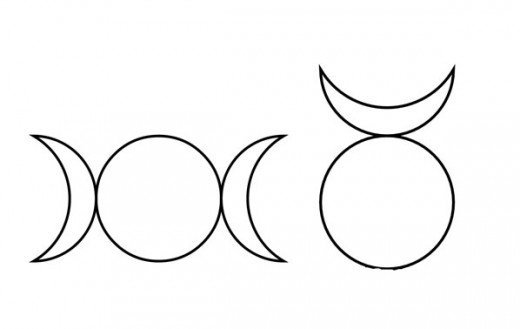
note: I occasionally compare/contrast Wicca to Christianity in this article. I'm not implying one is better than the other, or that they are the same (not by a long shot). Since Christianity is the dominant religion in Western society, most people are familiar with it. As such, I use it only to make analogies as a frame of reference.
TYPES AND TITLES - NOT NAMES
One quick way to settle a lot of confusion is to remind people of this: these terms in question are types of deities or titles of respect. Horned God is a type of Godhead, not one specific God. Triple Goddess is a type of Goddesshead, not one specific Goddess, or a specific trio of Goddesses. These terms are merely descriptions, not deities in themselves.
Likewise, Lord and Lady are titles of respect by which we call any God or Goddess, respectively; Lord and Lady are not names. Zeus is one Wiccan’s Lord, Thor is another Wiccan’s Lord, Lugh is another's... just as a Christian's Lord is YHWH (Jehova) though they call him 'Lord' and 'God'.
“The God” and “The Goddess” are not specific deities that all Wiccans worship; they are simply the generic term for “male” deities and “female” deities, respectively. So my God that I worship may not be the same God another Wiccan worships. But I still refer to him as God, 'the' God, or Lord.
“With all that said, if the concept of these specific gender labels or specific personas makes you uncomfortable, that’s completely valid!
When you dig to the very base of things, the idea isn’t specifically about opposite genders, it’s about polarity in union. For example, I revere the Light and Shadow of the Universe—two energies interlaced in perfect unity to form one infinite, omnipresent deity. So it is without that it is within, meaning I am both the student and the teacher, the slave and the master, the art and the artist, the created and the creator. The Universe is all around me but I am also a part of the Universe. Abstract, I know. Please note: Shadow is not “evil” or “bad.” An example would be: if Light is the sun then Shadow is the moon.
I recently had someone ask me if they could worship Gaia as both their God and Goddess and still be considered Wiccan. If we look at the Light and Shadow aspects of Gaia we see that polarity in union can easily be observed.
Then there’s Dianic Wicca (the female-only variety), where practitioners heavily acknowledge gender and do not acknowledge the Horned God, or the masculine. Yet, they still acknowledge polarities in union.
By upholding polarity in union, we are still able to honor the Sabbats effectively.
Now, if you favor the idea of choosing a pantheon and your deities, or if you believe you have been chosen by your deities, this is also completely valid. The collective consciousness of all the people believing in these personalities have, if they weren’t already real, made them real. Each god and goddess have their own unique traits and lessons to teach. To form a bond with the divine is a truly rewarding path itself.
-thesilverwitch
So why do Wiccans use all these titles and types instead of just using the name of their God/dess?
Originally in Wiccan covens, Wiccans didn't speak the names of the deities they worshiped outside the circle. This was to prevent others from defaming and disrespecting the deities.
This still holds today for a lot of Wiccans, though many eclectics are more relaxed on it. They might be willing to tell other Wiccans/Pagans, or close friends, who their specific God/desses are but not wish to divulge that information to just anyone.
For other Wiccans, the Horned God and Triple Goddess, or the Lord and Lady, or The God and The Goddess have taken on a persona of their own.
“Let me make a note here: Wicca has no high authority and no bible to dictate its laws. If someone views the Horned God and Triple Goddess as personas in themselves, then that is valid. These titles have evolved to harbor aspects of their own.” -thesilverwitch
Some would argue this is the result of watered-down eclectic Wicca and improperly trained practitioners who have failed to do any in-depth research. Others embrace the “All Gods are one God, all Goddesses are one Goddess” theory1which has become more prevalent with eclectics in the 1990s. These people would argue that all the various God/desses in mythology are either aspects or personifications of the same divine couple.
1. The “All Gods are one God, all Goddesses are one Goddess” theory actually didn’t originate in Wicca; it was from Dion Fortune, a Christo-Pagan Ceremonial Magician. This kind of ‘soft polytheism’ is probably as common in Wicca now as ‘hard polytheism’ (the belief that deities of different cultures are all unique and distinct beings).
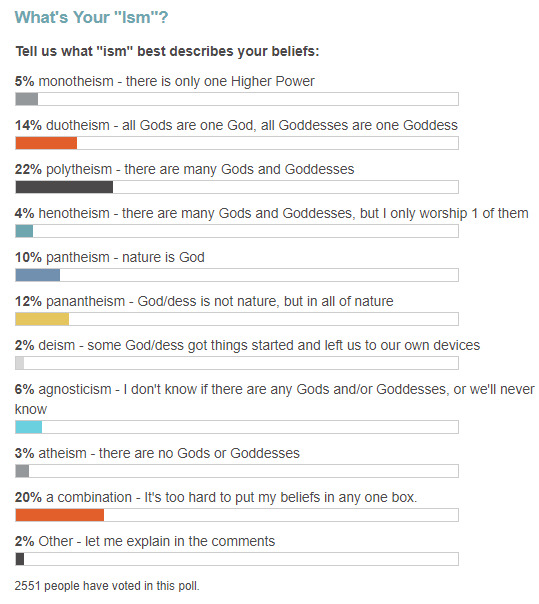
THE HORNED GOD
The very term “Horned God” is controversial, considering most of us grew up in a Christian-dominant society in which the only god-like being who had horns was 'the devil'. This is why the term 'Horned God' gets a lot of knee-jerk reactions.
There is no relationship, however, between the Wiccan view of Horned Gods and the Christian view of Satan. That would be like saying a pumpkin must be an orange in disguise because they have the same color skin. Horned Gods existed long before any concept of Satan did, and nowhere in the Bible was Satan described as having horns and hooves—those extra-biblical descriptions came from the Middle Ages.
Horned Gods were sometimes depicted as having curving, conical horns like the goat or ram, or sometimes the branched antlers like the stag. Sometimes they were animal-headed, and sometimes goat-footed. Some of the more well-known Horned Gods include Pan and Cernuous.
To ancient Pagans, Gods with horns were related to the wild and man’s primal nature. They represent mankind unencumbered by the trappings of civilization and living by his instincts in a natural state of being. Horned Gods were closely related to the forests—particularly the wild animals. They’re related to the hunt (both as hunter, the life-taker, and as hunted, the life-giver; thus, he perpetuates the cycles of life). They would often be associated with fertility— the virile male embracing his carnal desires without the imposition of social codes and mores guiding his behavior.
The Horned God made its way into Wicca due to the popular theories at the time by a handful of 19th century/early 20th century anthropologists who attempted to tie all of Pagandom together as if it were one universal pre-Christian set of beliefs that went underground to avoid persecution. Christianity had long painted Pagans as villains; in the age of enlightenment, many tried to look at history from a new and more open-minded perspective, and they romanticized antiquity. Some became desperate to turn the tables and paint Pagans as the victims. Ultimately, the attempts to oversimplify all the various Pagan religious from all over the world has been discredited, and the attempt to prove them going underground as a single surviving ancient cult has been debunked. Still, it was these oversimplified works that were prominent theories at about the time Wicca was forming, so it heavily influenced Wicca's formation.
To Wiccans, the Horned God motif fits in neatly in the Wheel of the Year, however it’s important to understand that just because many Wiccans worship a Horned God doesn’t mean they worship the same God.
Finally, not all Wiccans have a direct relationship with Horned Gods. Some Wiccans worship a Sun God, another god-type that fits neatly into the Wheel of the Year mythos and corresponds well to a Moon Goddess.
Remember also, that not all Gods are as easily “typecast”.
THE TRIPLE GODDESS
The most commonly known triple deity form today is probably the trinity in Christianity. If one can understand how Christians see the father, the son and the holy spirit as three, distinct persons in one, then one can understand how Wiccans view the Triple Goddess. In Wicca, many Goddesses are seen as having three forms that mirror the stages of womanhood:
The Maiden, who is the young, innocent, often (but not always) virginal beauty. She is independent and idealistic, ready to take on the world and looking to the future possibilities, filled with all the promise of what can be. She’s associated with youth, the time of coming of age, new beginnings, the new moon and spring fertility festivals.
The Mother, who is mature, experienced lover and (often, but not always) parent. She is nurturing and protective, representing the selfless giving of oneself to sustain others. She's associated with family, children, domestic issues, growth, sexuality, the full moon, the summer (when she becomes pregnant) and winter (when she gives birth).
The Crone, who is the wise, guiding, respected elder (but not necessarily grandmother) of the trio. She is strong and pragmatic. She represents the "dark" side-- fears, decay, and destruction. Not that this makes her 'evil'; rather, she's someone who guides us through some of the biggest challenges in her infinite wisdom. She's associated with changes and transformations (particularly the biggest transformation-- death and rebirth).
It should be noted that not all Goddesses fit neatly into a trio of Maiden, Mother and Crone. Just because a culture has a Maiden does not mean that they automatically must have a Mother and Crone counterpart. Historically speaking, this was not common. Even if a culture had Goddesses that would fit neatly into the Maiden, the Mother and the Crone categories, it should not be automatically assumed that they had a connection to each other.
Think of it this way: if you walked into a waiting room and found a college girl, a middle-aged mom, and a retiree, would you automatically assume they must be related because they occupy the same time and place? Of course you wouldn’t—the same thing can be said for Goddesses.
Most Goddesses will fit in at least one of these categories, but that’s simply because these are very generalized attributes. Not every Goddess in history is so easily stuffed in a box—many Goddesses can fit into more than one category. Consider Hestia, who can be simultaneously considered a Maiden Goddess (due to her virginity and never having children), but also a Mother Goddess (due to her association with domestic life, as keeper of the sacred hearthfires).
While the model of the Triple Goddess is useful in Wiccan mythos, a Wiccan must always be careful not to pigeonhole ancient Goddesses in groups of three.
“The triad is a beautiful concept and is useful to those who honor it in some way with deity/aspect correlation in either a literal or metaphorical manner. However, some sects aren’t so strict on the topic and that is perfectly valid. ” -thesilverwitch
SO WHO DO WE WORSHIP HERE?
I have been asked this by more new Wiccans (particularly the young ones) than I would like to remember: “Who is the Goddess? Is she the same as the Lady? Is the God’ the same one Christians worship? Is the Horned God Satan?”
So many Wicca books put so much emphasis on magic, herbs, crystals, runes, nature, etc., that deities for many people are sadly an afterthought. This baffles me, since anyone of any religion (or no religion) can love nature and be interested in magic. Wicca at its core has always been about relationship with deity. Why anyone feels they are ready to jump into a religion before they even understand who the religion worships—sorry, but it doesn't make much sense. That's putting the cart before the horse.
But the answer to that question is fairly straight-forward: we worship Pagan Gods, or, at the very least, the archetypes of them.
Some Wiccans worship a Horned God, some a Maiden, some a Mother, some a Crone, some more than one. Most will refer to their Gods as “Lord” or simply “The God” at one time or another, and most will refer to their Goddess as “Lady” or simply “The Goddess” at one time or another. ]
Bottom line: everyone’s experience with deity is personal and subjective, and it’s only through your exploration of your relationship with them do you begin to learn about who they truly are.
FINDING YOUR GOD AND GODDESS IN WICCA
Your Wiccan God and Goddess are really what it’s all about. That’s what the rituals are for. That’s why we celebrate the Wheel of the Year. That’s why we pray and meditate. Anyone of any religion can love nature. Anyone of any religion can cast spells. Anyone of any religion can work with tarot cards or crystals and such. None of these things particularly make anyone Wiccan—in fact, plenty of people who do these things are not at all Wiccan. People have been doing these things long before Wicca existed.However, fostering a relationship with the Gods as a Wiccan, connecting through Wiccan ritual, honoring them through the cycles of the seasons and by the way you live your life—this is what truly makes one Wiccan.
PATRON GOD AND MATRON GODDESS
Wicca is traditionally polytheistic, and many Wiccans will speak of their ‘patrons’… that is, a patron God, and a matron Goddess. Patrons and matrons (or just ‘patrons’ when referring to both) are the specific God(s) or Goddesses(s) a Wiccan honors and works with.
There’s no rule about patrons. I’ve known people to have as few as one, and as many as four or five. They are usually of the same pantheon (not always, though mixing pantheons is always tricky and never should be taken lightly).
The benefit of being in a relationship with patrons is that it gets fully developed. In your ongoing worship and serving your patron Gods, you get to know them intimately. In taking you under their wing like that, a God or Goddess will teach you a great deal over time and you can learn many lessons from them.
Sometimes you can be with the same patrons for life—other times, you’ll be with them for a time (usually a few years) before you reach the ‘end of the road’ with them. This is not a terrible thing, when a God or Goddess ‘cuts you loose’; it’s not because you did anything wrong, but because you’re ready to move on. This is when you've benefited from the relationship all you can, and they realize that you are ready for a new patron—a new teacher, who can bring you yet to the next level of lessons that need to be learned.
Having a patron does not mean you need to exclude all other Gods. In Wicca, we don’t believe the Gods are jealous or have the ‘have no other Gods before me’ policies as found in other religions you may be more familiar with. It’s okay to go to a ritual that worships another God, or to hold a ritual to a different Goddess if you wish for specific purpose.
It’s just that our patrons will be a special, ongoing relationship.
BEING CALLED BY THE GODS
A lot of Wiccans will tell you they did not choose their Gods, but that their Gods chose them.
Like many religions describe it, it feels like ‘a calling’, and as such it’s hard to explain. Many Wiccans feel they get signs of some sort. This may be an image or animal associated with a certain God or Goddess popping up a lot unexpectedly, dreams or visions. Often these are accompanied by those gut feelings, or an inner voice.
Where is this calling coming from? Is it truly a divine being who has chosen you and is communicating with you? Is it an internal, a simple ‘knowing’ in your own brain of what you need? I have my own ideas, but the truth is—no one knows.
Once you become Wiccan, though, it’s something you should look out for.
NOT GETTING A CALLING?
If you don’t feel the calling, you certainly should not feel bad. For one thing, maybe you’re just too new to Wicca and not ready to work with a personal deity yet. For another thing, perhaps you are just missing the signs. Don’t get discouraged—the deities aren't rejecting you.
You may need to simply employ a little initiative. Start seeking deities, and approach them to see which ones will have you (or have been waiting for you to come to them in your own time).
In other words, you don’t have to sit around and wait until you feel they've come to you—you can meet them half-way.
FINDING YOUR WICCAN GOD AND/OR GODDESS
Whether you feel the calling or not, there are things you should do to find patrons and foster that newly-growing relationship.
Do your research. Read, read and read some more to learn all you can about your Gods and/or Goddesses you think might be calling you. If you think you're getting a sign, look them up to see who they might be coming from. If you don’t feel a calling, this could be a good way to start figuring out the best road for you to take—starting with whichever pantheons catch your attention most is probably a good place to begin. Then see which Gods and Goddesses jump out at you.
You want to really acquaint yourself with God/desses initially. Be careful of Neo-Pagan books that try to fit all Gods into one mold and all Goddesses into one mold. You’re better off reading ancient mythology books that deliberately remain vague so not to be too specific.
Also beware of modern books that re-write myths to ‘white wash’ them to make people feel more comfortable (this happens often with ‘rape myths’ or other myths that are particularly violent and sad). Some Pagan authors prefer feel-good versions of the old myths, but they’re missing the point. Sometimes they have tough lessons for us, or they convey them harshly through myths—to change the myths is to change (and often lose) the lesson. Gods are not meant to be human ideals for us to live up to (that doesn’t mean you can’t strive to be like your gods), they are meant for us to learn something. Remember that the myths are symbolism and allegory; your Gods are not actually raping and killing. If a myth makes you uncomfortable, don’t try to avoid it—it only means there is a lesson there that you probably need to explore further.
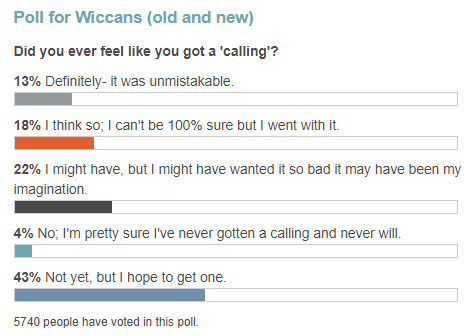
CONNECTING WITH DEITIES IN WICCA
Study pantheons and cultures. This requires more reading and studying, of course, but it’s necessary. Wicca is a modern religion, and despite what some shoddy scholarship will tell you, all Pagan religions are not based on that particular modern model.
Your Gods and Goddesses are used to being treated a certain way by the ancient cultures that revered them. You’ll want to uphold that expectation, just as if you were inviting a king or queen of another country into your home you wouldn’t want to offend them. You’d want to be the perfect host. Likewise, you want to be the perfect host if you are seeking a God/dess to come into your life.
You don’t want to make an offering of the harvest dinner that includes meat to a vegetarian Goddess. You don’t want to place something your God might find offensive on the altar. If your God is a warrior God, then embracing a life of pacifism and speaking out against war and violence is probably not a good idea. Every time you call war ‘evil’ it’s like a slap in the face to that deity. Not that you have to become violent in your own life or that you have to be eager for wars—but if you can’t appreciate that war might sometimes be a necessary action, perhaps a warrior God isn’t for you. If you truly believe in pacifism, you should probably find a God that advocates pacifism instead of trying to twist a warrior God to fit your mold.
Talk to the deities. If you feel called, begin praying to that deity. If you feel you wish to be called by a certain deity, pray to him or her. Pray for signs, or more specific signs. Pray for answers to come to you. Invite them into your lives, and into your heart.
Meditate—they say if praying is talking to a God, meditation is listening. Try to hear through that ‘inner voice’ what it is they are saying to you.
BEGIN HONORING YOUR DEITIES
A relationship takes time to build, and this is no different with Gods. If you feel you’ve found the right Gods, or your patrons, you should begin honoring those Gods.The best way to start this is by building a small shrine and going to it daily. It doesn’t have to be elaborate: something to represent your God and/or Goddess (a statue, a candle, a stone, image, etc.), some candles and/or incense to burn during worship, and a cup or bowl for libations and offerings.Go to your altar—daily is best, even if only for 5 minutes. Say a short prayer, hold a moment of silence, make a simple offering (some milk, honey, a flower, dried herbs, a portion of your breakfast or dinner, etc.).You might want to find out if your God or Goddess is associated with any sabbat, or has a special annual festival from the culture in which he or she originates. Celebrate it—do something special. Again, it doesn’t have to be elaborate, but perhaps you could hold a ritual, go on a nature walk, have a feast, make a special offering (such as donating food in the name of a harvest Goddess).Keep it up—books will tell you a lot about your Gods and Goddesses, but the only way to really get to know them is by making them a part of your life.
“Lastly, too often I see people who claim to be Wiccan who have altered these very basic concepts of divinity to the point of nonrecognition. Their God/s, Goddess/es, High Energies, Higher Powers, High Aspects, High Ideals, Gods-Within, Whatever-You-May-Call-It, Etc, no longer fit into the Sabbats whatsoever, which pretty much defeats the purpose of being Wiccan. If it doesn’t fit—it doesn’t sit. And if it doesn’t sit in Wicca, it probably sits somewhere else. And if it doesn’t sit somewhere else, don’t be so eager to place yourself under a label for the sake of a label. Just be you.”
-thesilverwitch
Sources: Buckland's Complete Book of Witchcraft WiccanSage
#pagan#wicca#wiccan#witchcraft#witches of Tumblr#witch#magick#deities#triple goddess#spell#goddess#god#easy spell#the craft#paganism#amethyst#moon#full moon#eclipse#nature#neo wiccan#neo pagan#gif#fashion#art#DIY#food#landscape#vintage#design
1K notes
·
View notes